
Find Your Sport

Lacrosse
Lacrosse is a team sport that uses a lacrosse stick and ball to play in 2 teams of 10 on a large field measuring 110 x 60 yards long. Players use their lacrosse sticks to toss the ball between team members and try to score into the opposing team’s goal. There are 5 different versions of Lacrosse: field lacrosse, box lacrosse, women’s lacrosse, lacrosse sixes, and intercrosse.
Lacrosse has its origins in North American Indigenous communities, with each team consisting of 100 to 1,000 men on a field several kilometres long. Games were ceremonial and were played for 2 to 3 days straight from sunup to sundown.
No prior skills are needed to get started with Lacrosse. It’s a physical sport that requires lots of running, hand-eye coordination, but is overall a great way to socialize and work together in teams!
Men’s adult lacrosse leagues typically allow for physical contact between players, while women’s adult and youth lacrosse does not. Adaptive versions of lacrosse, such as wheelchair lacrosse, have been developed to allow players with physical and/or cognitive disabilities to get involved with the sport.
-
Increased stamina, agility, and endurance.
Improves coordination.
-
To play Lacrosse, you’ll need a lacrosse stick, which is a stick with a mesh net at the end of it and a lacrosse ball. Protective equipment such as helmets, gloves, elbow pads, mouthguards, and a pair of cleats are also important.
-
Since some leagues allow for physical contact between players, you must be aware that you may get some bruises, strains and sprains, as well as some more serious injuries such as concussions.

Laser Tag
Laser tag is a fast paced and fun shooting sport where participants navigate a dimly lit arena with a light gun while wearing a vest with infrared-sensitive signaling targets. The objective of the game is to score points by “tagging” other players, or players on an opposing team, by using the light guns to hit the targets on their vests. The team or individual with the most points at the end of the game wins.
Laser tag has its origins with the United States military, where it was used for training. Its entry into the public occurred in Texas during the 1980s, where Star Wars inspired the opening of the first laser tag facility.
No special skills are needed to start. It is a fast-paced sport that involves lots of running, dodging and hiding in a dimly lit arena with structures to hide behind.
Wheelchair laser tag is an emerging adaptable version of the sport, which is played on a large, and flat open arena.
Adjustments to equipment, such as louder signaling targets, can help ensure that the game can be enjoyed by everyone regardless of physical and/or cognitive disability. Please contact your laser tag provider to ask if they’re able to provide you with any accommodation.
-
Improved hand-eye coordination and reflexes.
Increased stamina.
A fun and exciting way to get exercise!
-
All equipment such as the light gun, and vest with the targets will be provided to you at the laser tag facility. Make sure to come in comfortable clothes and athletic shoes.
-
The most common injuries in laser tag are bruises, slips, and falls from tripping, collisions with parts of the arena, or with other players. As with any sport, make sure you stretch and warm up thoroughly before entering the arena. Be aware of your surroundings and of other players to avoid injury to yourself or to other players.
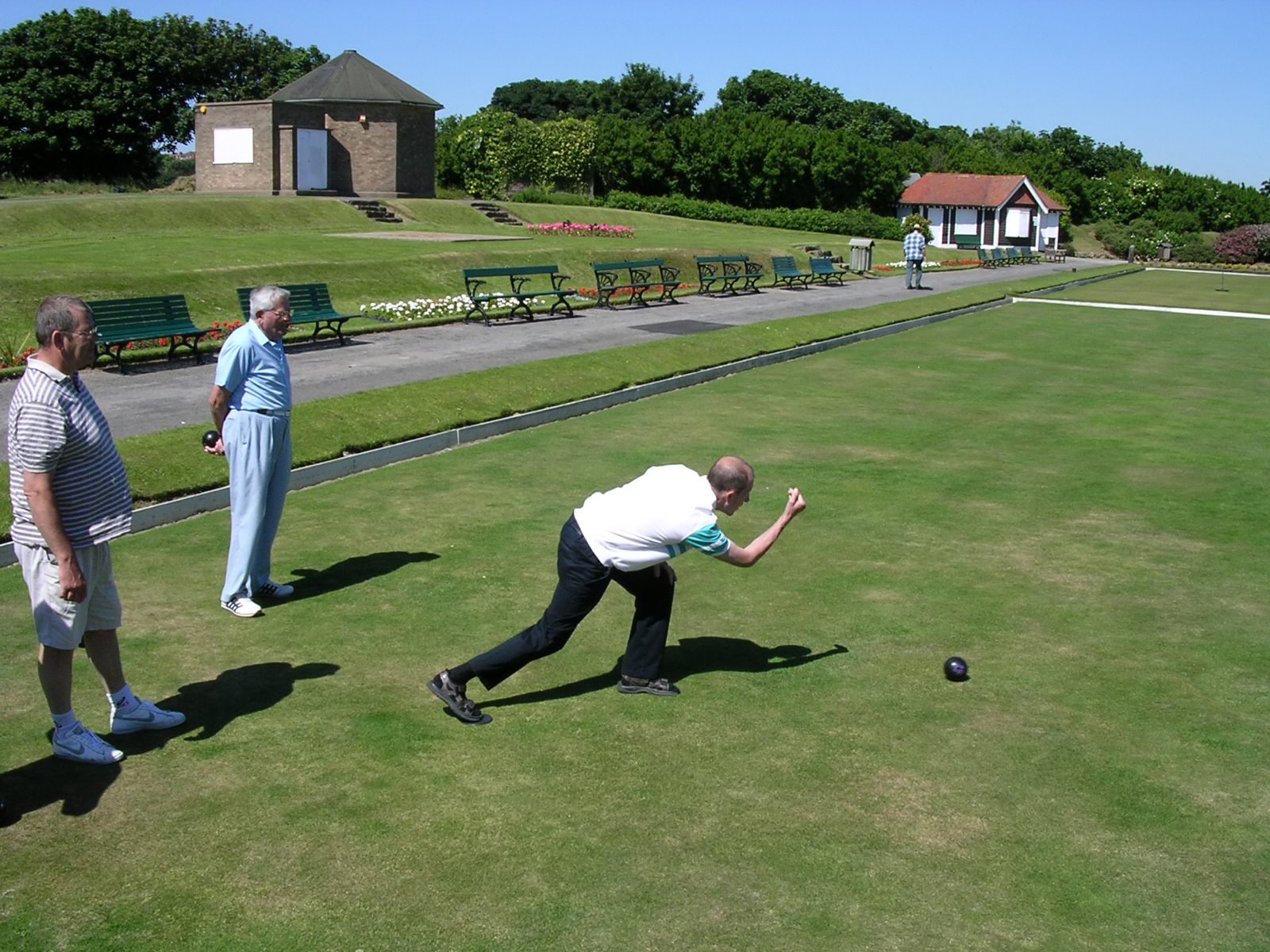
Lawn Bowling
Lawn Bowling is similar to the popular nine-pin bowling you find in bowling alleys, but is played on a green (on natural grass or artificial turf) in an outdoor space. The goal of the game is to roll a specialized ball, called “bowls”, as close as possible to a smaller ball, called a “jack”. The player who has reached 21 or 25 number of target shots will win the game.
The history of lawn bowling and its variants go as far back as Ancient Greece. A variation of the game similar to the modern version was first played in the 13th century in England and went on to evolve to its current version by the 19th century.
No prior skills are needed before getting started with lawn bowling. It is a relatively easy-going sport, which does not require a lot of strenuous activity.
Para lawn bowling, or para bowls, offers opportunities for participants with physical and/or cognitive disabilities to play the game. Specialized equipment and being partnered with an aid all help make the game more accessible to play for everyone.
-
Improved coordination and cardiovascular health.
Increased muscle strength.
Great way to socialize and meet new people.
-
To do lawn bowling, you’ll need to get your bowls, a jack and a lawn bowling green to play on. Remember to dress appropriately (comfortable clothes and athletic shoes) for the weather and bring your sunscreen and water bottle ready as you play.
-
The most common injury for bowlers occurs in the wrist, elbows, knee, hip, and feet due to overuse. Make sure to warm up properly and stretch your body before you play.

Luge
Luge is a high-speed winter sport where a luger lies down on a specialized sled and propels themselves down an icy track feet first. With the use of the calf muscles and the shoulders, a luger can steer their way along the track with speeds up to 150 km/hr—the fastest of the 3 sledding sports (skeleton, bobsleigh and luge). Lugers can compete either individually or in teams of 2.
The sport has origins in Switzerland during the 19th century where tourists in the winter resort town of St. Moritz rode sleighs between snowy alleyways and roads for fun. The sport became a part of the 1964 Olympic Winter Games in Innsbruck.
You do not need any special skills to get started with luge, however it does require a good balance of mental and physical control to be able to properly steer the sled.
Although an adaptive version of luge has yet to be developed in Calgary yet, please feel free to contact your luge club to see if they are able to provide any accommodation for you.
-
Improved cardiovascular fitness.
Increased strength.
Improved focus and concentration.
-
At the beginning, you may not need a luge suit. A helmet, gloves, and luge sled will be provided to you at the luge facility. If you want to continue luging more seriously, you may need to purchase the suit, helmet, gloves and a sled.
-
Bruises, cuts, and pain to the neck and abdominal muscles are the most common types of injuries that lugers will sustain during training and competition. However, more serious injuries such as concussions can occur. Ensure that you’ve warmed up and stretched thoroughly, and make sure that all your safety equipment is on and properly secured before hitting the track.

Mixed Martial Arts
MMA, or mixed martial arts, is a popular form of full combat sport that involves the use of various forms of martial arts such as Muay Thai, boxing, wrestling and Brazilian Jiu Jitsu. You might be more familiar with the sport through highly popular televised UFC competitions where fighters compete in the ring under a certain set of rules and regulations.
Combat sports have been present throughout history, with MMA-style competitions found in records in Ancient China and Ancient Greece. Modern-style MMA originated from the late-19th century in Europe and Asia with informal fighting and wrestling competitions before exploding in popularity in the 1960’s and ‘70’s thanks to martial artists such as Bruce Lee.
You don’t need any special skills to start doing MMA. It is a fast-paced sport that will test your hand-eye coordination and reaction skills. You’ll learn all the basic skills and forms through class and gradually work your way up to mastering various fighting styles.
Adjustments to classes, gear, and environment make the sport more accessible to those with physical and cognitive disabilities. Personalized classes, or smaller class sizes make it less intimidating and more engaging for participants. Contact your local MMA school to see if any accommodation can be made to make learning more enjoyable.
-
Increased endurance.
Increased strength.
Relieves stress and builds confidence.
-
You can wear a T-shirt/tank top and shorts to your lessons and won’t need a special uniform; however, you’ll need MMA gloves and protective gear, such as a helmet and mouth guard.
-
Since MMA is a full contact sport, there is a higher risk of injury. Bruises, muscle tears and strains are common, but more severe injuries such as concussions and broken bones are a possibility, especially in competition. However, the risk of injury is greatly lowered when closely supervised, or when in a class setting. Always remember to thoroughly stretch and warm up before sparring to lower the risk of injury.
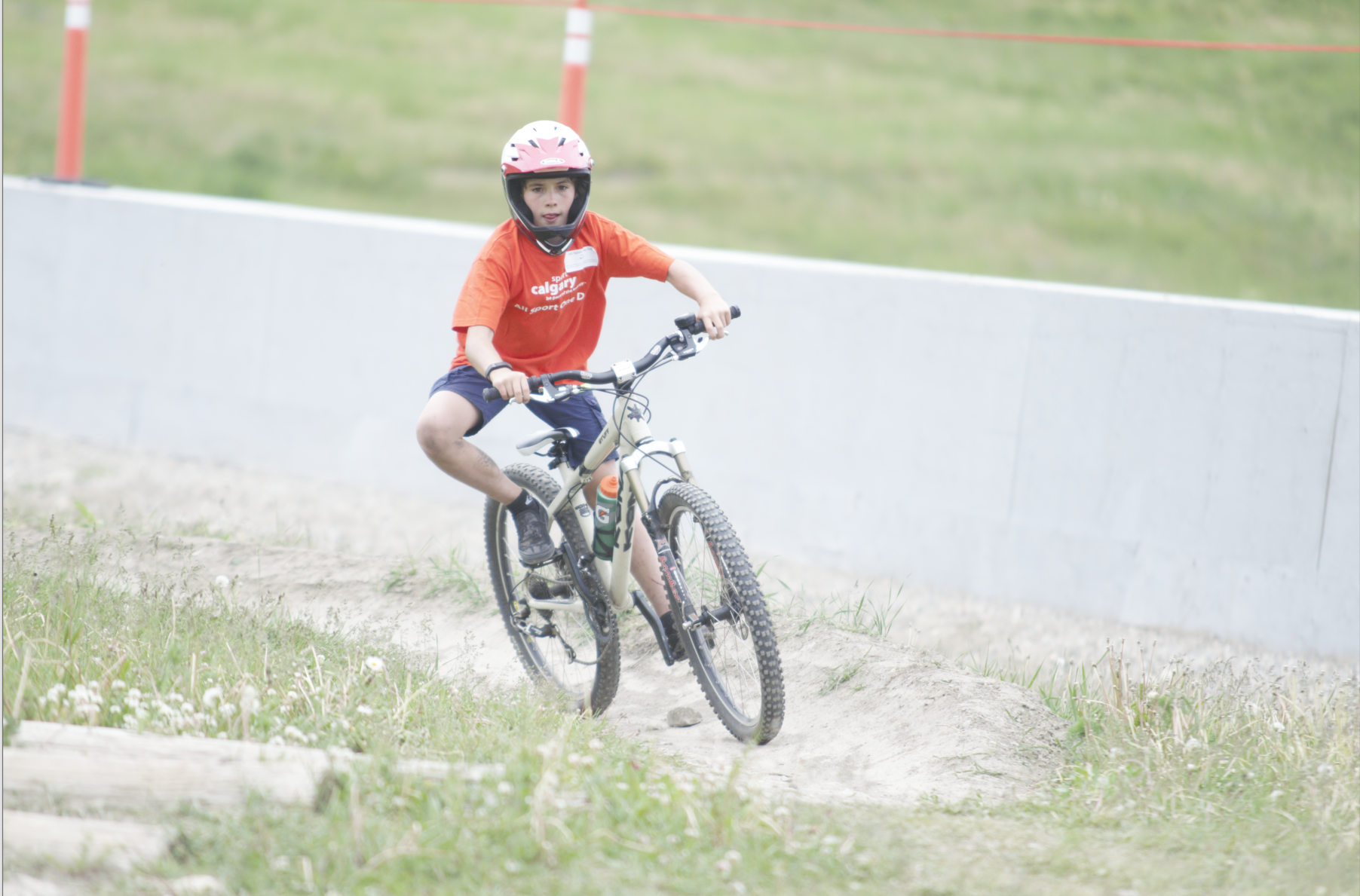
Mountain Biking
Mountain biking is a sport where bikers will take their mountain bicycles off-road onto rough terrain for recreation or for competition. You can find trails in local parks, or trails in the mountains specifically for mountain biking. There are multiple mountain biking categories such as: cross country riding, trail riding, and downhill riding.
Both the modern sport of mountain biking and the creation of the mountain bike is said to have developed in different parts of the United States during the 1960’s and 1970’s. Different biking clubs each developed their own versions of the mountain bike, and the sport became increasingly popular by the 1990’s.
Before you start mountain biking, you’ll need to feel comfortable riding a bike. Knowing how to start, stop and maneuver your bike will be essential to learning how to navigate rough terrain. You can start by practicing in a quiet street, or in a big field to get used to the feeling of your bike.
Adaptive mountain biking allows individuals with physical and/or cognitive disabilities to participate in the sport. Specialized bikes such as the recumbent and kneeling handcycle, and the bucket bike allow for a more accessible mountain biking experience.
-
Increased muscle strength.
Increased cardiovascular health.
Improved balance and coordination.
-
You’ll need a mountain bike, a helmet (which can be rented), biking gloves, knee pads, elbow pads, comfortable clothes, shoes with a grippy bottom, a water bottle and first aid kit.
-
The most common injuries for mountain bikers include scrapes and cuts, as well as pain in the lower back and knees. The source of many of these injuries is falls. Be aware of your surroundings and environment, ensuring that you are well prepared in case of any emergencies.
Similar Sports: Cycling, BMX, Track Cycling

Muay Thai
Muay Thai, AKA Thai boxing, is a Thai combat sport that involves various striking, kicking, and clinching techniques.
Muay Thai is said to have originated as a military martial art practiced during the 16th century in modern-day Thailand. The sport became popular internationally in the late 20th to 21st century when Muay Thai practitioners started to compete in competitions around the world.
No prior skills are required before you start learning Muay Thai. It is a fast-paced sport that will test your hand-eye coordination and reaction skills. You’ll learn all the basic skills, stances, and techniques during your classes.
Muay Thai can be made adapted to make it more accessible for individuals with physical and/or cognitive disabilities. By making changes to routines, and the sparring areas, Muay Thai can be made more accessible to everyone.
-
Strengthen cardiovascular health.
Increase self-confidence.
Increase flexibility.
Relieve stress.
-
You can do Muay Thai in a comfortable T-shirt and shorts. Boxing gloves, head gear, and shin guards are provided at the facility.
-
Since Muay Thai is a combat sport, the risks of injuries are much higher. Bruises, sprains, blisters, and muscle strains are all common injuries when participating in Muay Thai. It’s important to stretch, warm up and ensure that all your protective gear is on properly before sparring.
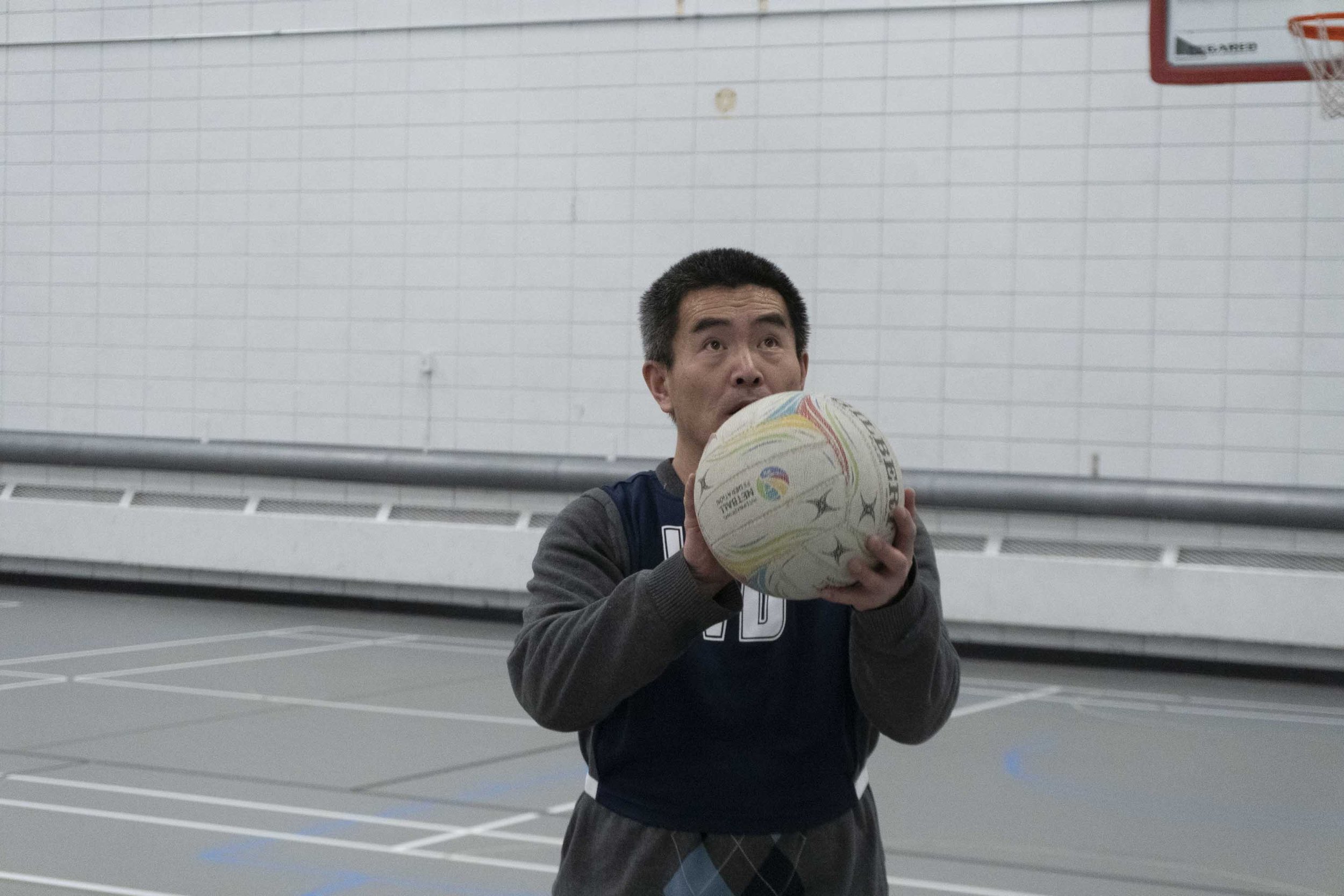
Netball
Netball is a team ball sport played on a court where two teams of seven try to shoot the ball into the opposing team’s raised goal ring to score points. Although similar to basketball, it differs in rules and equipment. It is a sport that was created primarily for women and girls, although the sport is now open for anyone to play.
The sport’s development began with the misinterpretation of basketball rules by an American sports teacher in 1895, these misinterpreted rules soon became the beginnings for the rules of netball. It became known as women’s basketball first, before standardized rules for netball were established in 1960.
No previous skill or experience is needed to start playing netball. It’s a fast-paced sport that requires lots of running and jumping for the ball.
Many modifications to the rules of netball have been made to make the sport more accessible for individuals with physical and/or cognitive disabilities. Walking netball and wheelchair netball are examples of adaptive netball.
-
Improves hand-eye coordination and flexibility of the body.
Improves upper body strength.
Learn teamwork skills.
-
To get started, you’ll need a pair of running shoes, comfortable clothes, as well as a court to play on, nets and a leather or rubber ball.
-
Although physical contact is regulated, players are still at risk of common injuries such as slips and falls, hand, and knee injuries, as well as sprains, bruises and dislocations.
Similar Sports: Basketball, Quidditch
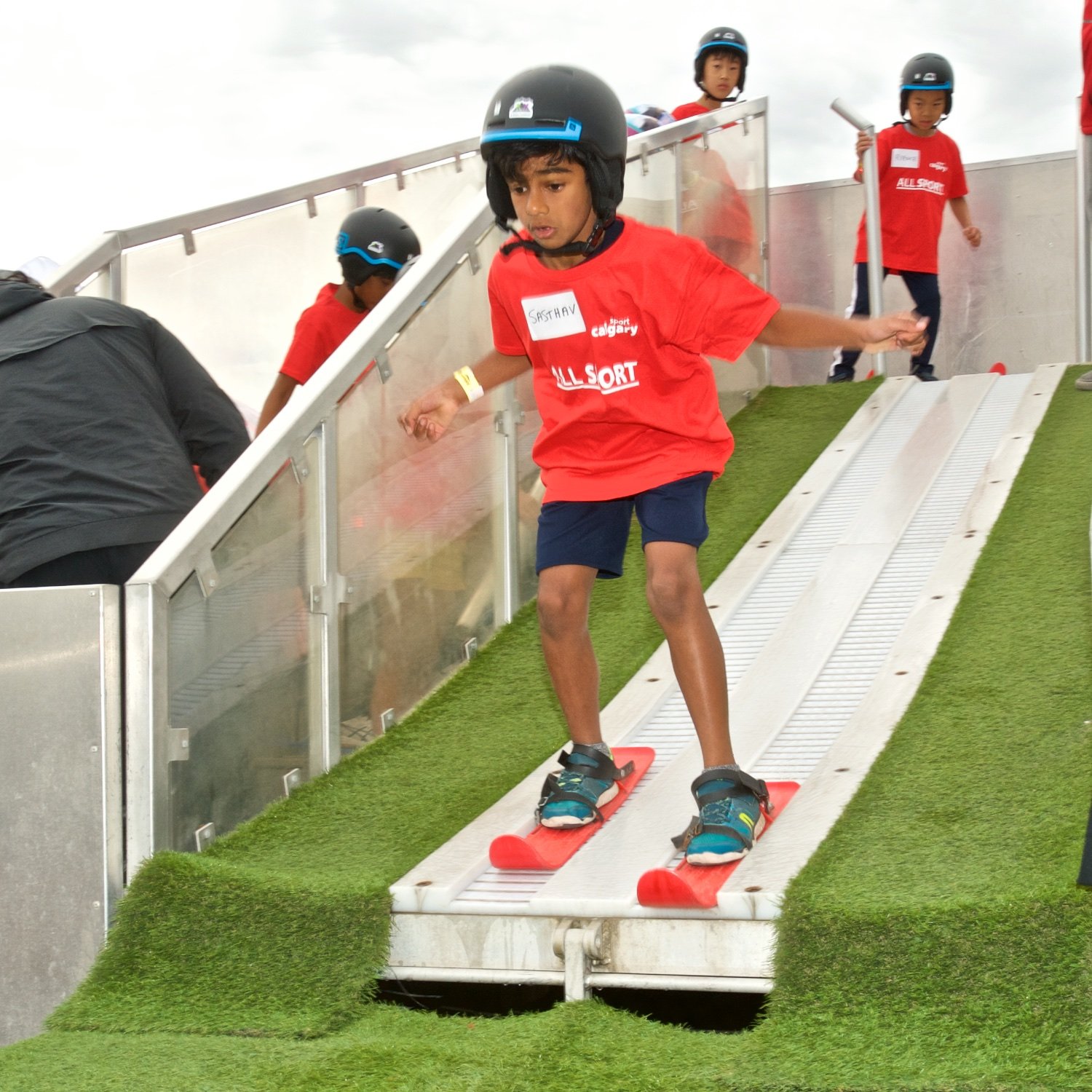
Nordic Combined
Nordic Combined is a snow sport in which athlete’s compete in both cross-country skiing and ski jumping. During competitions, an athlete’s ski jumping results will determine the time advantages/disadvantages when competing in the cross-country skiing segment.
The first ever Nordic combined competition took place in Norway in 1892 and has been a part of the winter Olympic games since 1924.
Skiing is an essential skill needed to participate in Nordic combined events. Be sure you’re familiar and comfortable with being on your skis before you train. There’s never a wrong time to start learning how to ski!
Although there are no official rules for an accessible version of Nordic Combined, cross-country skiing has become adapted to be accessible to all participants with physical and/or cognitive disabilities. Adjustments made to equipment, as well as the use of guides, have allowed everyone to be able to participate in the sport.
-
Full body workout.
Cross-country skiing is a low impact sport.
Increases stamina and endurance.
-
You’ll need a pair of cross-country skis, ski poles, jumping skis, ski boots, helmet, gloves, goggles, ski jumping suit.
-
Be aware of falls, sprains, and tears, especially to the legs. Concussions may also occur during the ski jumping portion of the sport. It is always important to ensure that you warm up and stretch as well as ensuring that your protective gear and equipment is on properly before participating.
Similar Sports: Skiing, Snowboarding
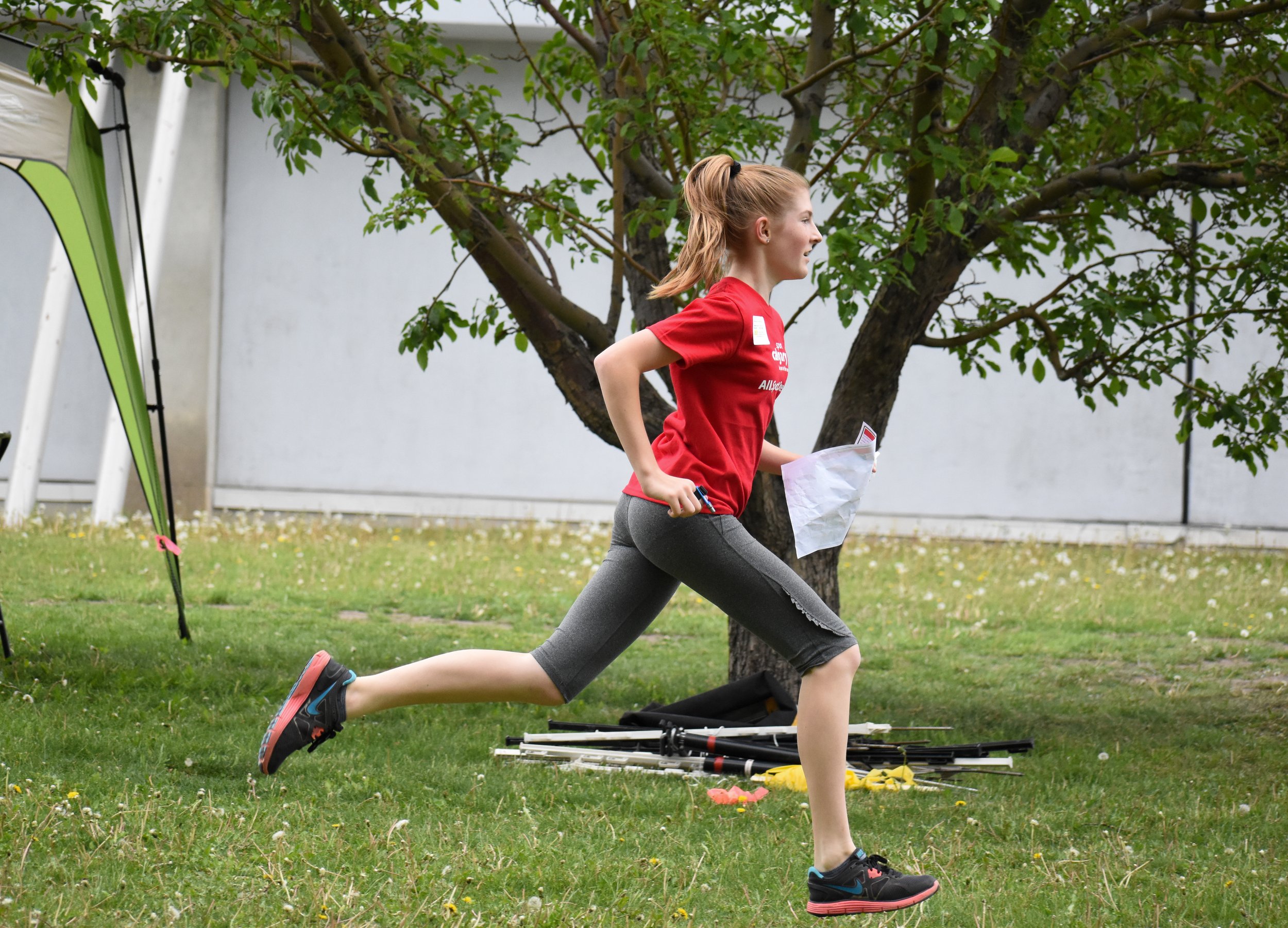
Orienteering
Orienteering consists of a group of sports where participants use a compass and map to navigate from one point to another on unfamiliar terrain at speed. There are multiple variations including foot orienteering, mountain bike orienteering, ski orienteering, and trail orienteering.
The sport began in Sweden in the 19th century as a part of military training before becoming a sport for civilians. The first orienteering competition open to civilians was held in Norway in 1897.
Before getting started, make sure you know how to read a map and use a compass. It is important that you can keep track of your own location without getting lost while navigating the terrain. It’s also a good idea to go in a group, or with an experienced partner for your first orienteering session.
Orienting can be made adaptive for individuals with physical and/or cognitive disabilities by carefully choosing the right terrain that fits your needs. By doing so, you can enjoy the outdoors at your own pace without any time pressure.
-
Learn essential outdoor skills.
Enjoy being outside in nature.
Increase cardiovascular capacity.
-
Proper clothing and footwear for the weather and navigating the terrain. You'll need a map of the orienteering course, and a compass which will be provided to you by the orienteering club.
-
Because many orienteering activities involve being out in the wilderness, it is important to strictly follow the rules set up by the event organizers. You’ll need to carry a whistle in case you get lost or injured while on course. Make sure that you’re prepared for unexpected scenarios such as bad weather, or even wildlife encounters.
Similar Sports: Hiking

Paddleboarding
Paddleboarding is a water sport where you stand, kneel or sit on a paddleboard, which is a large flat board made of an EPS foam core, and use a paddle to propel yourself across the surface of the water.
Paddling has been deeply rooted in human history, particularly within Polynesian cultures where the earliest versions of the paddleboard were used for travel between islands. The first modern paddleboards were developed in the 1930s, which were promoted as a tool for lifeguarding. After decades of relative obscurity in the public eye, paddleboarding experienced a comeback in the 1980s and 1990s, and exploded in popularity in Hawaii.
No special skills are required to start paddleboarding. You’ll need to have a good sense of balance before jumping on the paddleboard, as well as be comfortable on water and know how to swim.
Modifications made to paddleboards and paddles, such as a paddleboard seat, or paddleboard stabilizers, make it easier for individuals with physical and/or cognitive disabilities to participate in the sport. Contact your paddleboard provider to see if they have any accommodation for you.
Similar Sports: Sailing, Wakeboarding, Waterskiing
-
Improved balance.
Improved cardiovascular health.
Improved endurance.
-
You’ll need a paddleboard, or a surfboard, and a paddle, which are available to rent at most outdoor aquatic recreational facilities. Wear swimwear, or clothes that you don’t mind getting wet, and make sure to always wear a life jacket when you’re out in the water.
-
Common paddleboarding injuries include sprains, tears and pain and soreness to various parts of the body. More serious injuries include concussions. Make sure that you stretch and warm up thoroughly before heading out into the water. Always wear safety equipment such as your life jacket, be aware of your surroundings, and make sure that you’re well prepared and dressed for the weather.

Padel
Padel is a racquet sport that is a hybrid of both squash and tennis. The sport is played in doubles format, with one team on each side of the court (65 x 32 ft wide), with a net dividing it in the middle. The court is enclosed by glass walls that can be used in play, making for dynamic and enjoyable sport.
Padel originated in Mexico in 1969. Soon after, the sport spread to Europe, then to South America before gaining popularity worldwide in the 2010s.
No special skills are required to start playing padel. It is a fast-paced game that requires quick reflexes but is simple enough to understand that you can start playing right away.
Wheelchair padel is an adapted version of the sport, where adjustments to rules are made to make it more accessible to those with physical and/or cognitive disabilities. Padel can also be played as a form of rehabilitation for those recovering from various injuries. Contact your padel provider to see if they can provide any accommodation for you.
-
Improves cardiovascular activity.
Improves hand-eye coordination and flexibility.
Improves teamwork skills.
-
You’ll need a padel racquet, which differs from a tennis racquet in that it has a flat, solid surface with small holes rather than strings. A padel ball, or a regular tennis ball can be used to play.
-
Common padel injuries occur most often in the knees, elbows, and lower back; the main cause being overuse. It is important to stretch and warm up thoroughly before playing, as well as know when to stop and rest.
Similar Sports: Pickleball, Squash, Tennis

Parkour
Parkour is a sport where participants attempt to get from one point to another in the fastest and most efficient way without equipment that involves running, jumping, rolling, climbing and other acrobatics.
The sport has its roots in military training and martial arts from communities around the world. It became popularized in the 1990s and 2000s through popular media.
There are no special skills needed to start doing parkour. It is a physically demanding sport that requires lots of movement of your entire body. You’ll learn how to maneuver, and maybe even learn some basic acrobatic skills, for tackling different types of terrain during your classes.
Contact your parkour class providers about accommodation for participants with physical and/or cognitive disabilities, such as smaller or private classes.
-
Strengthen problem solving and decision-making skills.
Strengthen core strength.
Improve agility.
-
No equipment is required for parkour! Just wear your most comfortable, fitted clothing and a pair of athletic indoor shoes.
-
Parkour is a sport that requires maneuvering different types of terrain, and participants can sustain bruises, and strains. However, in your classes, the area will be thoroughly padded with soft mats and other materials to cushion your falls and stumbles.
Similar Sports: Gymnastics, Circus
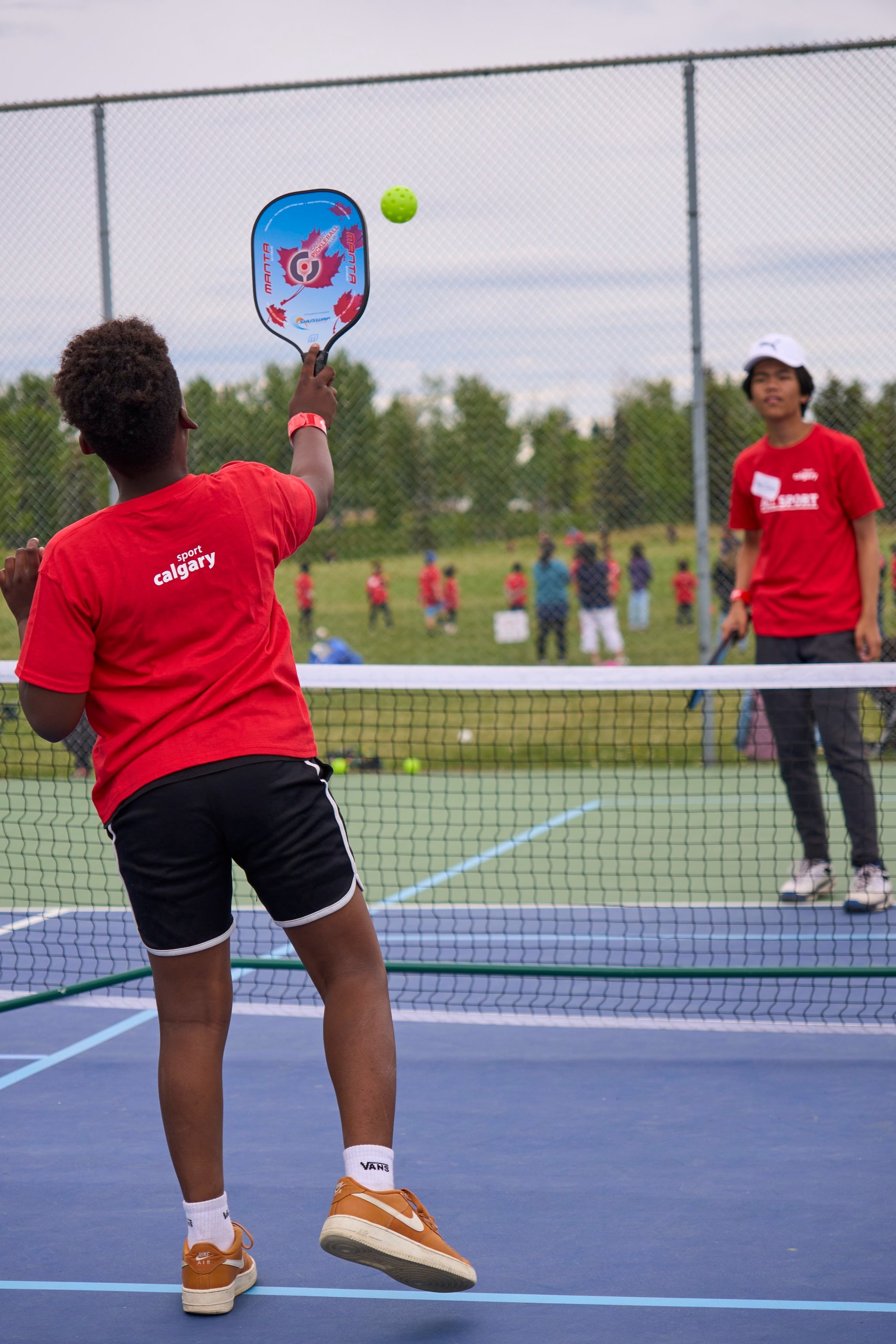
Pickleball
Pickleball is a paddle sport played with two (singles) or four (doubles) players on a 44 x 20 ft court that resembles a tennis court. Unlike other racquet sports, the sport is played with a paddle and a plastic ball.
Pickleball was invented in the summer of 1965 in the United States by three fathers and their children who were bored and needed a new game to play. Together, they invented a new paddle sport that eventually came to be known as pickleball.
No prior skills are required to play pickleball. Compared to tennis, pickleball is relatively low-impact and a sport that is easy to learn how to play.
Pickleball has been adapted to make it accessible to wheelchair users. Hybrid games are common, where wheelchair pickleball players play with a person who is standing up and play with the rules of adaptive pickleball.
-
Increased muscle strength.
Improves hand-eye coordination.
Improves balance and agility.
-
You’ll need a pair of athletic shoes, comfortable clothing, a pickleball paddle and pickleballs to play. Although still a relatively new sport, pickleball courts are easily accessible and easy to find.
-
Although pickleball is a relatively low impact sport, injuries such as falls and sprains are still common. Ankle sprains, muscle tears and knee injuries often occur when pivoting and moving around the court. Make sure to thoroughly warm up your body and stretch before playing.
Similar Sports: Table Tennis, Tennis
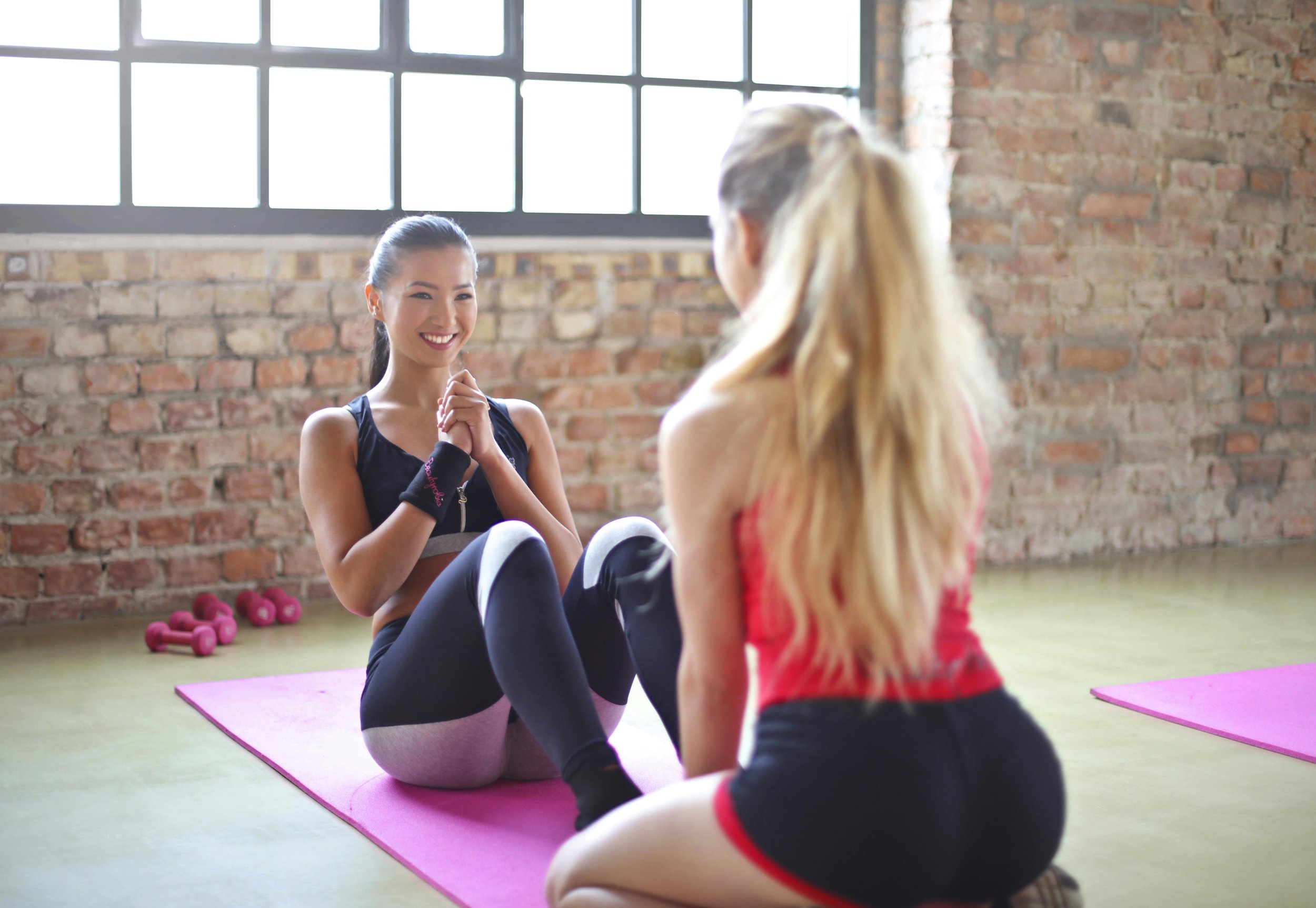
Pilates
Pilates is comprised of a series of repetitive exercises meant to work both the body and the mind. These exercises place a greater emphasis on the “5 essentials” – breathing, cervical alignment, rib and scapular stabilization, pelvic mobility, and utilization of abdominal muscles, and are repeated 3 to 5 times per set.
Pilates was developed by Joseph Pilates during World War I while he was held in an internment camp and developed exercises alongside fellow inmates to strengthen the body and mind.
Pilates requires a sense of balance, mobility, and a bit of flexibility. You will be able to develop these skills the more you practice since the exercises simple to follow and don’t require any special equipment.
Pilates is an accessible sport in the sense that it can be done almost anywhere. Many choose to practice it from the comfort of their own homes, while some may even attend classes in parks and at local community centres.
Pilates can be made adaptable by adjusting certain exercises for physical therapies, or through the use of furniture, such as chairs, to put less strain on the body. Contact your pilates provider to see if they offer any accommodation that you may need.
-
Improved flexibility and muscle strength.
Improved posture and balance.
Increased muscular strength.
-
All you need to wear to do pilates is comfortable clothes. You may be provided with a yoga mat at your pilates studio.
-
Apart from muscle soreness after doing pilates, common injuries include lower back and/or neck pain from improper technique and overuse. It is important to warm up thoroughly beforehand and to know when to stop and rest to prevent putting strain on your body.
Similar Sports: Yoga
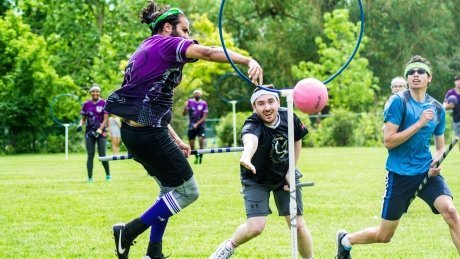
Quidditch
The sport of quidditch originates from the Harry Potter novels. Minus the magic, quidditch is played similarly to how it is in the books. There are four positions chaser, keeper, beater and seeker. In order to earn points the chasers must try to get the quaffle (ball) through their opponent’s hoops. The goal of the game is to have the most points by the time the snitch is caught.
Quidditch has something for everyone. Previous experience playing sports is not necessary just a willingness to learn. Clubs are often very welcoming to people interested in learning how to play, so grab your broomstick and head down to the pitch.
Youth leagues as well as low or no contact leagues are in existence depending on how competitive people want to play. Wheelchair quidditch has also been established, making the game more accessible to all players.
-
Improves cognitive skills
Improves cardiovascular health
Provokes creativity
-
Basic equipment like a slightly deflated volleyball, a few slightly deflated dodgeballs and six hoops are required to play. Specific player equipment required include runners or cleats, and a broomstick.
-
Quidditch is a full contact sport. Concussions can result from play, so it is important to practice proper protocol before returning to the game. Regulations are in place to reduce injuries during play and games are refereed for increased safety.

Racquetball
Racquetball is a team racquet sport similar to squash, but played with a different kind of racquet and ball on a larger court with a different set of rules. One major difference is that the ceiling is included as a playable surface along with the walls and floor. It can be played in singles or in doubles format.
Racquetball originated in Connecticut during the 1950s by a professional tennis player looking to develop a new racquet sport inspired by others such as tennis and squash. At first, it was called “paddle rackets,” before being renamed in 1969 as “racquetball.”
There are no special skills needed to begin playing racquetball. It is a fast-paced sport that requires quick reflexes, but it is simple enough to understand that you can start playing right away.
Wheelchair racquetball is an adapted version of the sport, with adjustments made to the rules, that make it easier for players with physical disabilities to participate.
-
Improved hand-eye coordination and agility.
Works out the entire body.
Improves balance.
-
You’ll need a racquetball racquet and a racquetball. Safety equipment such as safety glasses and/or gloves are highly recommended when playing. Racquetball courts are available to rent at various leisure/recreation centres around Calgary.
-
The most common racquetball injuries include cuts and bruises. More serious ones include injuries to the eyes, sprains, and fractures. It is important to be aware of your surroundings and other players when playing racquetball, as well as making sure that you warm up thoroughly and rest to avoid any serious injury.
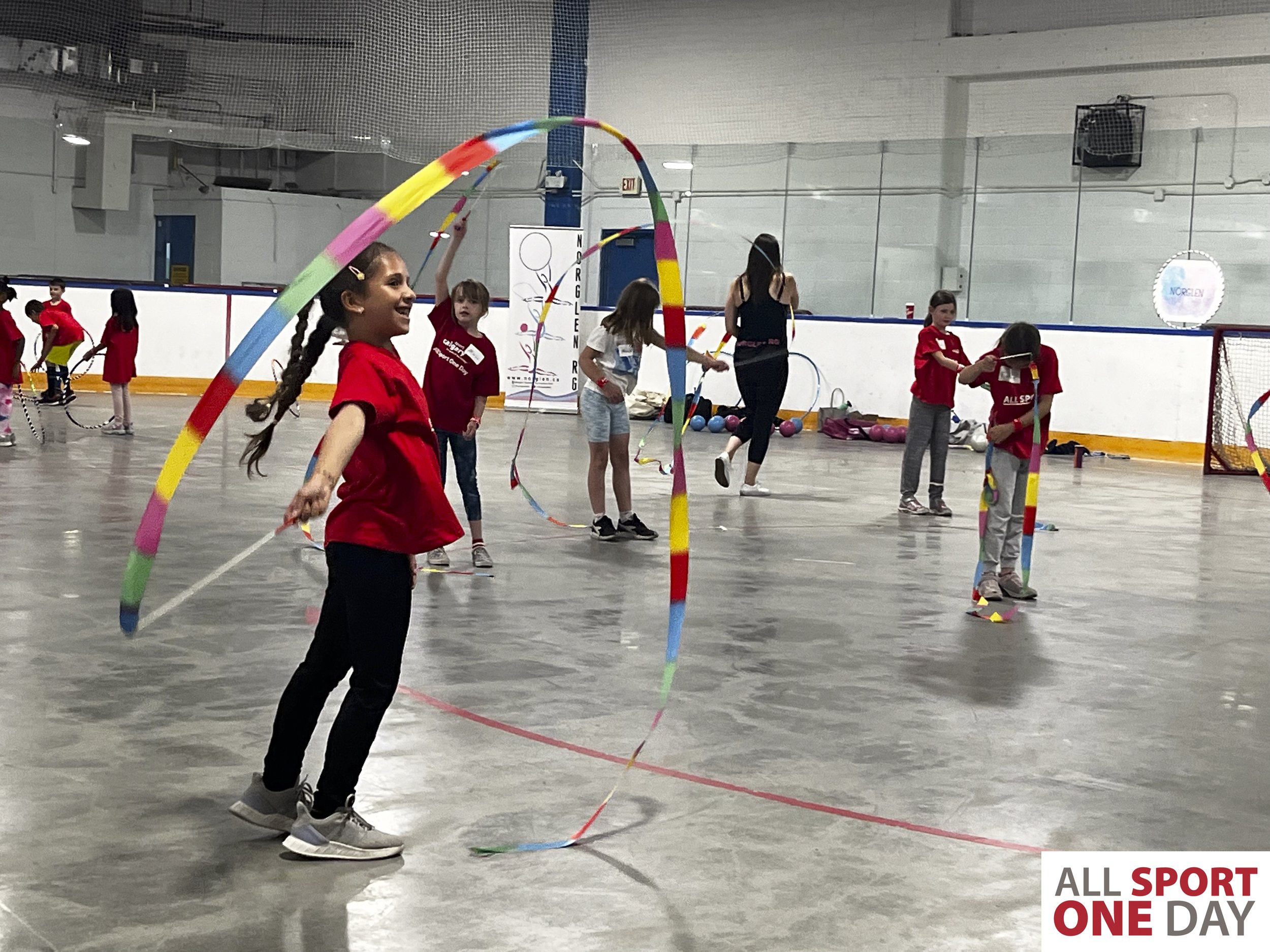
Rhythmic Gymnastics
Rhythmic gymnastics is a sport that involves performing on a gymnastics floor with multiple pieces of equipment such as hoops, balls, and ribbons while performing intricate routines involving different types of acrobatics. The sport can be performed individually or in groups.
The origins of rhythmic gymnastics date back to 19th century Europe, where group calisthenics for women was performed with music. The addition of equipment such as sticks was introduced in the 1900’s to increase flexibility as well as stretch the muscles. Rhythmic gymnastics eventually went on to become an Olympic sport at the 1984 Games in Los Angeles.
There are no special skills required to start learning rhythmic gymnastics. This is a sport where you’ll be making use of your entire body to perform intricate acrobatic routines. You’ll learn all the basics such as flexibility, coordination and balance before moving onto more advanced techniques.
Rhythmic gymnastics routines can be adapted to fit the needs of individuals with physical and/or cognitive disabilities. Please contact your rhythmic gymnastics provider of choice to ask if they are able to provide any accommodation for you.
-
Improves balance and coordination.
Increases strength.
Increases flexibility.
-
Depending on the club, you most likely will not need any special equipment. Come to classes in comfortable form fitting athletic clothes to avoid limbs from getting caught in clothes. Equipment such as balls, hoops and ribbons will be provided. If you wish to pursue rhythmic gymnastics competitively, you will most likely need to purchase a bodysuit.
-
Common rhythmic gymnastics injuries include strains, sprains and bruises. More serious can include fractures and dislocations. Remember to stretch and warm up thoroughly before practicing. Be aware of your surroundings and of other gymnasts to avoid injury to yourself and to others.
Similar Sports: Artistic Swimming, Figure Skating, Gymnastics

Ringette
Dubbed as the “fastest sport on ice,” ringette is a no-contact ice sport played on a rink with hockey skates, straight sticks, and a rubber ring. The goal of the game is to score as many points as possible into the opposing team’s goal. Although it seems similar to ice hockey, it has its own set of rules and regulations.
Ringette was created in Ontario, Canada in 1963 and was developed as a sport to encourage women’s participation in sport. Nowadays it’s a sport that can be played by anyone no matter what sex, or gender.
Before starting ringette, you’ll have to know how to skate to keep up with the game. It is a fast-paced sport that requires lots of control over your movements on the ice.
Adaptive ringette allows for players with physical and/or cognitive disability to get involved in the game. Adjustments made to equipment, rules, and other types of assistance make the game more accessible for all.
Similar Sports: Floorball, Ice Hockey, Lacrosse
-
Increased cardiovascular balance and hand-eye coordination.
Increased muscle strength.
Learn how to play with a team.
-
To play ringette, you’ll need a pair of hockey skates, a ringette stick, ringette ring, a helmet with a ringette mask, shoulder pads, mouth and neck guards, protective gloves, and ringette pants.
-
Although ringette is a no-contact sport, there still presents a risk for injuries that include muscle strains, head injuries and fractures. Be sure to have all your protective equipment on properly and to stretch and warm up before you play.
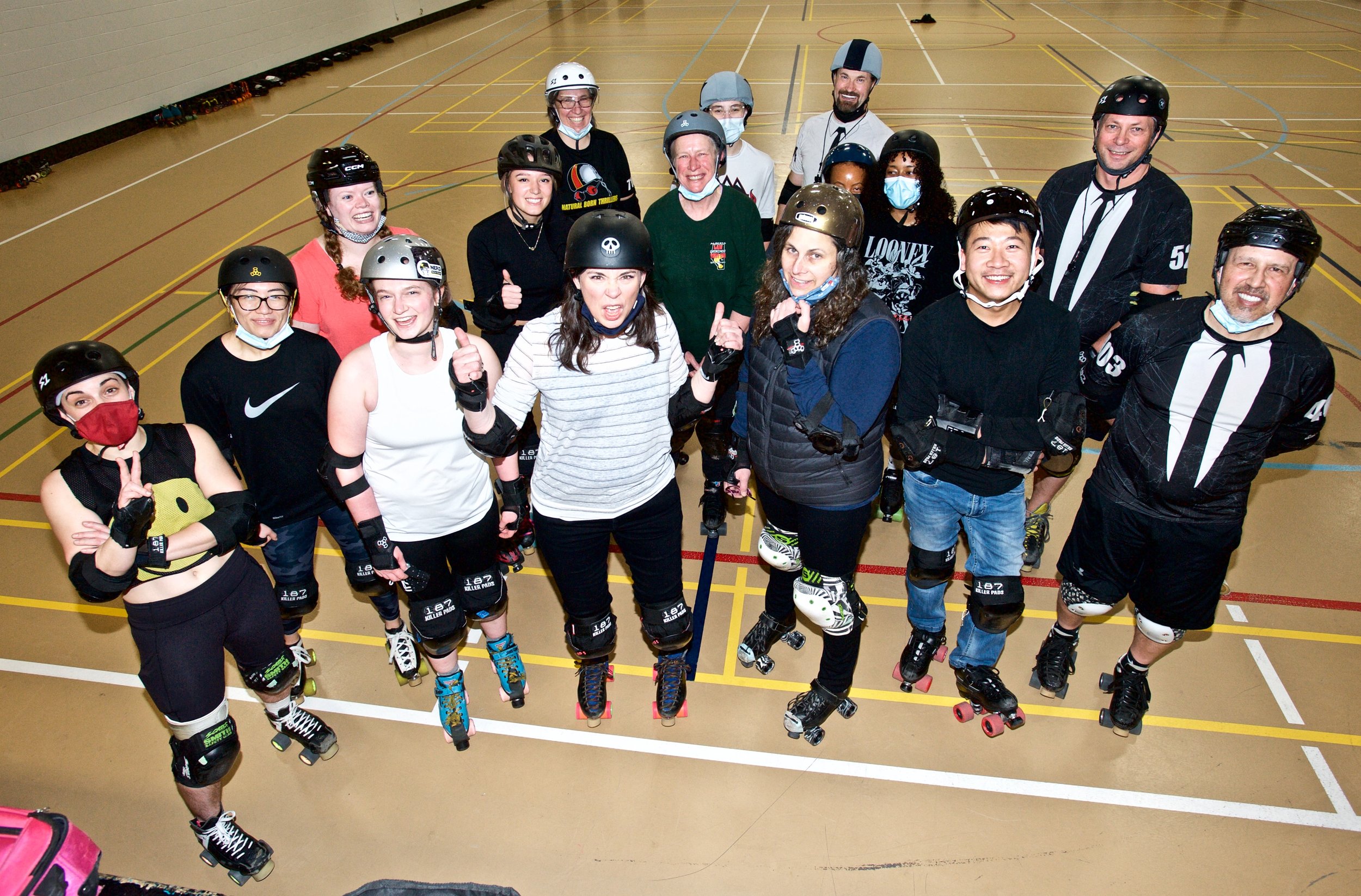
Roller Derby
Roller derby is a contact team sport played on a track between 2 teams of 5 players. Each game lasts 60 minutes, called a “bout”, and consists of several 2-minute rounds, called “jams”. Each team consists of “blockers” and “jammers,” with jammers trying to score points by lapping blockers, and with blockers trying to prevent opposing jammers from scoring points against their team.
Roller skating emerged as a popular endurance sport in the late 1800s before evolving into a competitive contact sport by the 1930s. It became highly popular during the mid-1900s, through televised competitions, then again in the early 2000’s through the reality TV show, Rollergirls.
Players must know how to roller skate, as well as be comfortable with maneuvering, stopping, and slowing down at a moment’s notice. It is a highly physical and fast-paced sport that involves strategizing and working together as a team. Although it has been popularized as a sport only played by women, there are several leagues that welcome all players, regardless of sex, ethnicity, and gender.
Although there is yet to be an adaptive version of roller derby, you may contact the league you’re interested in to ask if there any accommodations that can be made for you.
Similar Sports: In-Line Skating, Inline Hockey, Speedskating
-
Improves cardiovascular health and endurance.
Improves balance.
Improved teamwork skills.
-
To participate in roller derby, you’ll need roller skates, protective gear such as a helmet, knee and elbow pads, and gloves. Wear fitted athletic clothing to avoid getting caught on things and causing injuries.
-
The most common roller derby injuries include bruises, cuts, sprains, and strains. More serious injuries can include concussions, as well as broken bones. It is important to be aware of your surroundings and other teammates while playing. Always remember to warm up thoroughly before playing.

Rowing
Rowing is a racing sport in which players or teams propel themselves across a body of water in narrow boats with fixed oars. Rowers in professional events, such as the Olympics, will row a course that is about 2 km long.
Rowing as a sport began in the 17th to 18th century in England between boaters (who provided taxi services) on the River Thames in London. These kinds of races began to gain popularity in the 19th century and became widespread in the rest of Europe and in America.
No experience is required to start rowing! You do need good arm and shoulder mobility to be able to row with the oars, so make sure that you warm up and stretch your entire body before you get into the boat.
Adaptive rowing, is a category of rowing for those with physical disabilities. Modifications and adjustments are made to equipment depending on the disability of the rower to make it easier for them to participate. Contact your preferred rowing provider to see if they are able to provide any accommodations for you.
-
Full body workout.
Increases muscle strength.
Increases muscle and joint mobility.
-
To participate in rowing, you’ll need a boat, oars, and a life vest; all of which can be rented. Make sure to wear comfortable clothes (and an extra change of clothes) and dress appropriately for the weather.
-
Rowing can cause injury to your upper and lower back, knees, and wrists, so make sure to stretch and warm up thoroughly before getting into the boat. Blisters on the hands are also common for rowers as well. Ensure that your life vest and other safety equipment is on properly.

Rugby
Rugby is a close-contact team sport similar to American football where two teams, with 15 players each, play on a field 223 X 342 feet long while running with the rugby ball in hand. Teams must score against each other by having the ball touch the ground in the goal area of the opposing team.
Rugby had its start at a school in Rugby, England in the early 1800’s. The rules were codified in 1845 before the game spread all around Europe, before going worldwide.
No prior skills are needed to learn how to play rugby. The sport involves lots of running, tackling and ball-handling. Make sure you are well-prepared and thoroughly warmed up before playing.
Wheelchair rugby is an accessible version of the game that allows participants with a physical disability to get involved. The basic rules and objectives of the game remain the same, but instead of playing with a standard rugby ball, it is played with volleyballs instead.
-
Increased endurance and cardiovascular health.
Improved agility.
Learn to work together in a team.
-
You won’t need any fancy equipment when you’re just starting out. A T-shirt and shorts with a pair of athletic shoes is enough to start. If you want to take up rugby more seriously, you’ll need a rugby jersey, shorts, long rugby socks and cleats, as well as your rugby ball. Rugby balls are available to rent if you’re looking to play recreationally than competitively.
-
Common rugby injuries usually occur in the legs and shoulders, with the most common being sprains and strains. Rugby is also a contact sport, so tackling related injuries is also common. Be sure to thoroughly warm up and stretch before playing.
Similar Sports: American Football, Soccer

Running
Running is a great way to get fit. Whether you participate in marathons, triathlons, trail running, or do it just for fun, it can be an exhilarating way to get exercise and make you feel good.
Running for sport and competition has always been a part of human history. The most popular origin myth for the marathon began in Ancient Greece where a messenger ran from a battlefield to Athens nonstop to declare Greek victory.
No prior skills are needed for marathons! You’ll be able to build up your stamina the more you train. A regular training regimen will greatly improve your running endurance.
Running can be adapted for participants with physical and/or cognitive disabilities. Runners can be accompanied by guides, or support runners while completing their running course.
-
Increased endurance.
Improve cardiovascular fitness.
Relieves stress and anxiety.
-
No specialized equipment is needed. Wear your most comfortable clothing for exercising and a comfortable and sturdy pair of running shoes.
-
Common running injuries occur in the legs and feet, such as overtraining, aching in the knees, arches of the feet and in the shins. As usual, it is important to stretch and warm up before going on a run and know when to rest to avoid overexerting your body.
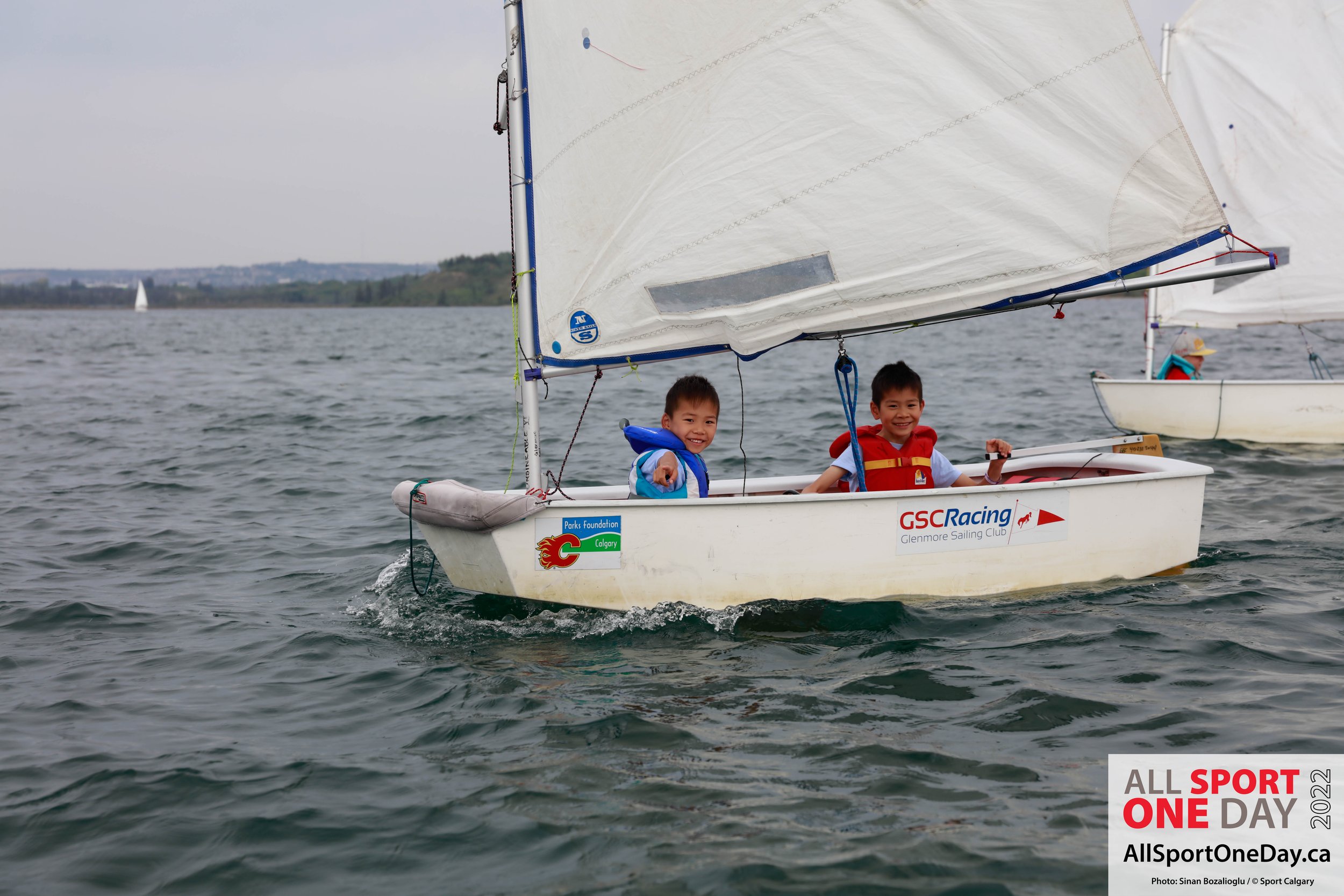
Sailing
Sailing is a competitive boat racing sport that is carried out individually, in pairs, or in teams that take place in relatively calm waters, like a lake, or harbor, along a coast, or even in the open ocean.
Sailing as a sport is believed to have originated in the Netherlands in the 17th century. As it became increasingly popular in Europe, the sport eventually spread to North America, where some of the oldest running yacht clubs still exist today.
You don’t need any special skills to start sailing. Depending on what kind of boat you sail, it can be a great workout for not only your body, but your brain as well! You’ll learn all about the theory of sailing, parts of the boat and other important safety procedures during your sailing lessons.
Specially designed boats, such as the Martin16 and the Access Dinghy, along with equipment such as The Hoist, which help individuals board boats, make sailing a breeze for participants with physical and/or cognitive disabilities.
-
Improves strength and endurance.
Improves teamwork skills.
Improves communication skills.
-
Other than your sailing boat (which you can rent, or are provided to you during your lesson), you’ll need safety equipment such as a life jacket, and a helmet. Come to your lessons in comfortable clothes that you don’t mind getting wet and/or waterproof clothing. Make sure to prepare and dress accordingly for weather conditions.
-
Common sailing injuries include sprains, strains and bruises, as well as overuse injuries to the back and knees from training too much. Falling into the water and tipping over from your boat are also potential sailing risks. Ensure that you’ve stretched and warmed up thoroughly and that all your safety equipment is on and secured properly before hopping into your boat.

Shooting
Shooting sports are precision sports that involve the use of equipment such as rifles, a bow and arrow, and shotguns that are made specifically for sport, to shoot at targets placed at set distances from the shooter. The goal of these sports is to score the most points by shooting as close to the centre of the targets as possible. These sports can be done individually or in teams.
Shooting grew out of its military use in the United States, where hunters eventually started to use spring-powered artificial targets as a form of competition. Shooting competitions made its debut at the Athens Olympic games in 1896.
There are no special skills needed to get started in shooting sports. Beginners will be taught how to use equipment, as well as be given a comprehensive explanation on safety and handling procedures. Some facilities may require you to complete a safety course before handling any equipment. Depending on the shooting sport, you may need to sit, stand, and/or lay flat on your stomach for a short period of time as you adjust your aim.
Adaptive shooting sports allows individuals with physical disabilities to participate in these sports. Adjustments to equipment, such as rifle stands, the shooting range and techniques, allows for easier access to the sport.
Similar Sports: Archery, Biathlon, Axe Throwing
-
Increased focus and concentration.
Increased arm strength.
Increased core strength.
-
Come to the shooting range in comfortable clothing and closed-toed shoes. You’ll be provided with equipment, such as the rifles, handguns, or shotgun, at shooting facilities. Safety equipment such as safety glasses and ear coverings will also be provided for you.
-
Common shooting sport injuries include pain in the back, neck, and shoulders from holding poses for long periods of time and handling equipment. Ensure that you are warming up and stretching thoroughly before stepping onto the shooting range. Keep in mind that you are also handling equipment that, if handled incorrectly, could injure someone. Make sure to follow all safety rules and ensure that your safety equipment is on properly.

Skateboarding
Skateboarding is a sport where a rider rides on top of a board with four wheels, called a skateboard, and performs tricks while on flat ground, or in a skatepark. Skateboards can also be used for leisure, as well as a mode of transportation.
Skateboarding originated in the 1940s and 1950s, where surfers in California wanted something to do while they weren’t out in the waters. The first skateboards were made from wooden boards with wheels attached to the bottoms, and the activity was called “sidewalk surfing”.
No special skills are needed when first trying out skateboarding. You can develop and/or practice your balancing skills as you learn to skateboard.
Adaptive skateboarding is an emerging sport with several popular skateboarders with physical disabilities taking the helm to promote the sport and support beginner adaptive skateboarders. An example of adaptive skateboarding can be seen with physically disabled and visually impaired skateboarders, who will use their mobility canes to navigate skateparks. Please contact your skateboarding provider to ask if they can provide any accommodations for you.
Similar Sports: BMX, Inline Skating, Snowboarding
-
Increased cardiovascular strength.
Improved hand-eye coordination and reflexes.
Improved balance.
-
You’ll need to dress in comfortable clothing with a pair of comfortable athletic shoes. Bring a helmet, elbow and knee pads, a water bottle, and snacks. Depending on the skateboarding provider, you may be provided with a skateboard. Please contact your provider for any further information.
-
The most common skateboarding injuries include sprains and bruises to various parts of the body. More serious injuries can include fractures to the elbows, wrists and ankles. Many of these injuries are caused by falls while performing tricks. Please ensure that your protective gear is on properly before skateboarding, and to be aware of your surroundings to prevent injury to yourself and to other people. Don’t forget to warm up and stretch thoroughly before skateboarding.

Skeleton
Skeleton is a winter sliding sport, like luge and bobsleigh, where a single athlete does a running start down the track before jumping onto the skeleton bobsled, sliding down the icy track while laying down face down and head-first. This is the slowest sport of the 3 sliding sports (luge, bobsleigh and skeleton).
Skeleton originated in Switzerland in 1882, where toboggan tracks were constructed in winter resort towns for tourists to slide down for fun. The sport made appearances at the 1928 and 1948 Olympic programs, before becoming a permanent addition in 2002.
No special skills are required before learning how to skeleton. You’ll be taught all the safety precautions and techniques of sliding during your lessons.
Although there is yet to be an adaptable version of skeleton, please contact your skeleton provider to ask if they can provide any accommodations for you.
-
Increased muscle strength.
Increased cardiovascular fitness.
Improved focus and concentration.
-
In the beginning, you may only need a helmet, knee and elbow pads. A sled will be provided for you at the sliding centre. If you want to start doing skeleton more seriously, you’ll need a skeleton helmet, a skeleton suit, spiked shoes, face shields, goggles and the skeleton sled.
-
The most common injuries for skeleton athletes include neck and back pain, and hamstring strain. More serious injuries include concussions. Remember to stretch and warm up thoroughly and ensure that all safety equipment is on properly before you hit the track.
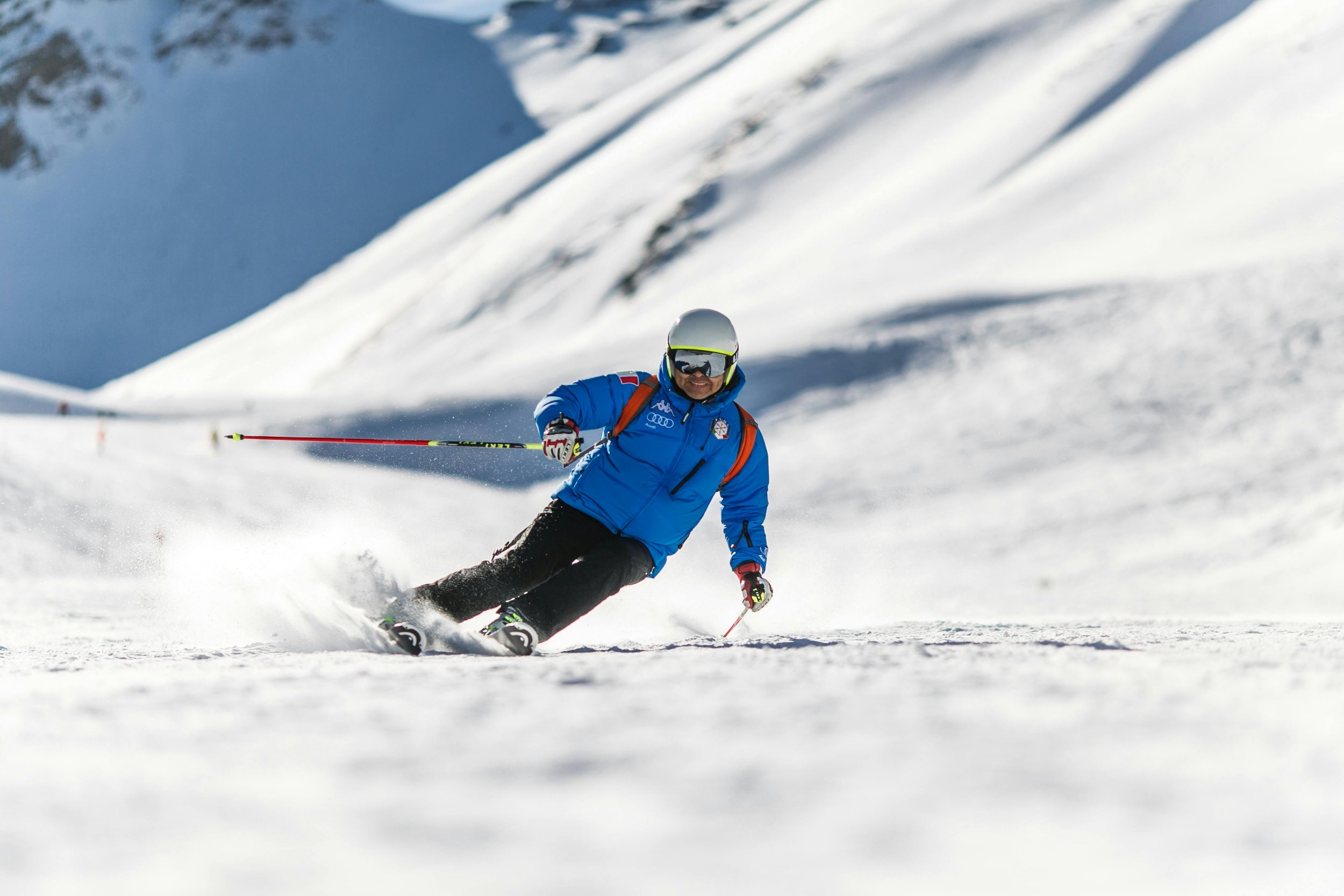
Skiing
Skiing is a winter sport that uses a pair of skis, thin strips made of laminated material such as plastic that attach to your feet, to glide down/across snowy terrain. There are several types of skiing such as alpine, Nordic and cross-country, which can be done competitively, or recreationally.
Modern skiing originated from Scandinavian countries, where the Old Norse word for ski, “skíð” means to “split a piece of wood or firewood.” Skiing was mostly used for transport up until the 19th century, where it became a sport for amusement.
You don’t need to have any prior specialized skills to start skiing. It requires a good sense of balance and requires the use of your core and leg muscles the most. You’ll learn all the basic skills during your classes and lessons.
Adaptive skiing involves the use of modified skiing equipment, such as a bi-ski, which is a seat with two skis attached to it, or techniques to make the sport accessible to participants with physical and/or cognitive disabilities.
-
Improves balance and flexibility.
Strengthens muscles and bones.
Boosts your mood.
-
You’ll need skis, ski poles, ski boots, a helmet, a winter jacket, snowpants, and gloves. Many ski hills and resorts as well as outdoor equipment rental services will have skis, ski poles and boots available for rent.
-
Common injuries that skiers have usually involve sprains, dislocations, and bruises to the lower part of the body. It is also important to check the skiing conditions before you go to make sure that the visibility of your ski course does not present any risks or hazards.
Similar Sports: Snowboarding

Skipping
Skipping, or jump rope, is an accessible and enjoyable recreational sport where participants jump over a long rope that passes over the head and under the feet. There are multiple ways to play, including with multiple ropes and participants. You can play recreationally or competitively.
Skipping is an activity that has a history of hundreds of years, but the first report of the sport can be traced back to Ancient China, where children would play it during New Year celebrations.
There are no special skills or equipment that you need to get started. It is a fast-paced sport. The only thing you’ll need to do is to hop, jump and skip over the rope. Don’t be discouraged if you can’t get it down perfectly on your first few tries. Practice makes perfect!
Adaptive jump ropes are available to suit the needs of participants with physical disabilities. For example, The Bar is an adaptive jump rope that consists of a bar (to hold) and a rope connected to each side to allow for one-handed skipping. Another adapted piece of equipment are Split Ropes, which are two separate shortened ropes that are held in each hand and are meant for seated skipping.
Similar Sports: Gymnastics, Parkour
-
Improves cardiovascular fitness.
Improves hand-eye coordination and balance.
It’s an enjoyable activity to add to your exercise routine!
-
Skipping is an easily accessible sport that can be played anywhere at any time. All you need is a skipping rope and yourself (and maybe a friend or two!). Wear comfortable clothing and ensure that you aren’t wearing anything that could get caught in the skipping rope as you play.
-
Sprains and strains in the legs, ankles and feet are the most common injuries in skipping. Jump ropes can also present a risk if participants are not aware of other participants and/or their surroundings. Be sure to stretch and warm up thoroughly before skipping and be aware of your surroundings as you play.
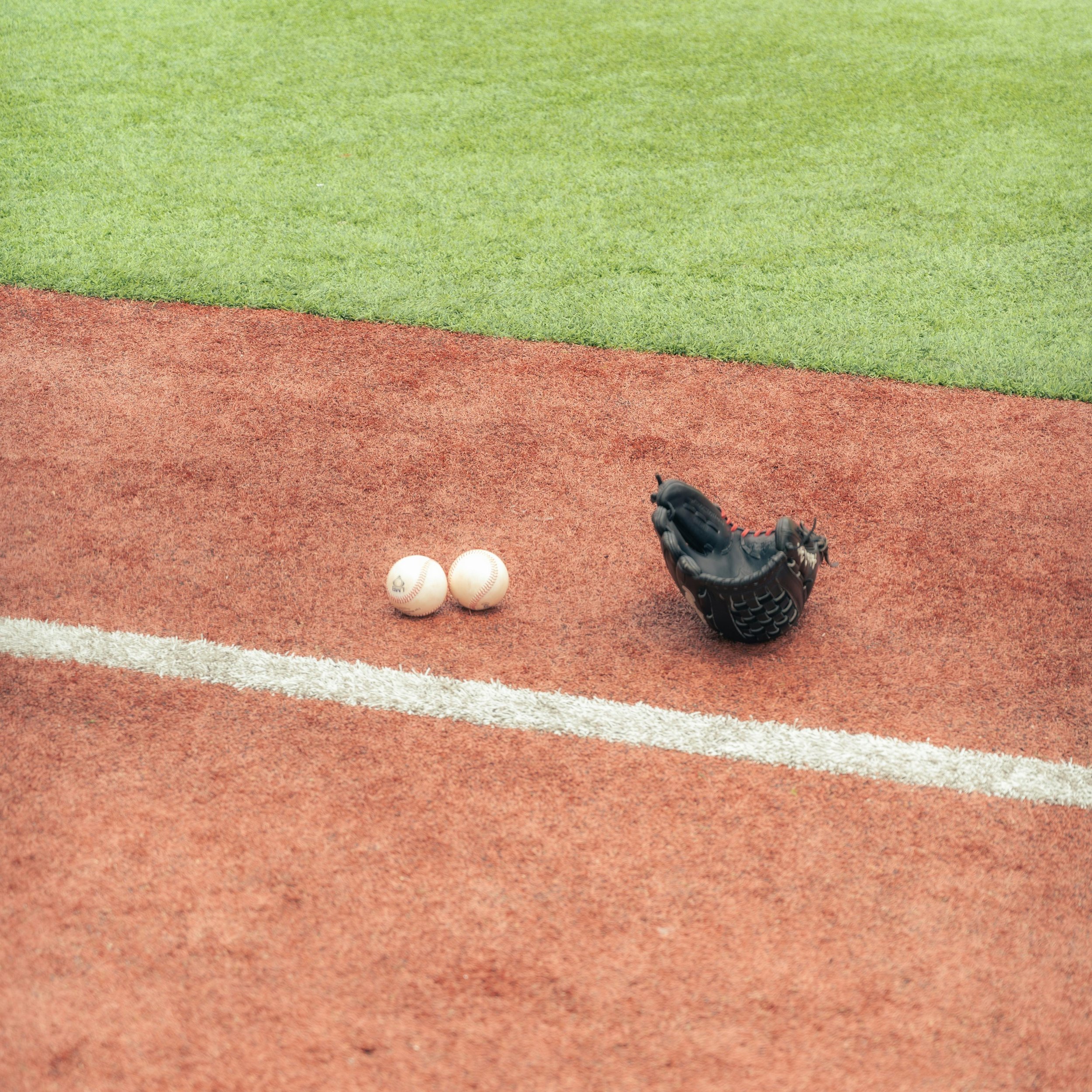
Slo-pitch
Slo-pitch is an alternative version of baseball that is slower and more laid-back. Like baseball, the game is played on a baseball diamond between two teams, with one team on the offence and the other on the defense. One major difference from baseball is that the ball is pitched underhand in a slow arc to the batter.
Slo-pitch originated in the late-19th century by a group of young men in Chicago. It grew to become more popular in the United States throughout the 20th century and soon became a standardized game with its own leagues.
You do not need any special skills to get started with slo-pitch. Although it is a slower version of baseball, it does require use of your entire body as you swing the bat, pitch the ball, and run between bases.
Adaptive slo-pitch allows for participants with physical and/or cognitive disabilities to get involved with the sport. Modifications made to the playing diamond and to equipment make playing more accessible.
-
Improved cardiovascular strength.
Improved strength.
Improved teamwork skills.
-
To play slo-pitch, you’ll need a softball (which is bigger and softer than a traditional baseball), a softball bat, and softball gloves. You may also want to consider wearing safety equipment such as a baseball helmet. You can play softball at your neighbourhood baseball diamond with a group of your friends.
-
Common injuries that slo-pitch players sustain include sprains, scrapes, bruises, tears and sometimes concussions. Participants must ensure that they warm up, stretch thoroughly and have all safety equipment on properly before playing. Ensure that you are aware of your surroundings and other players on the field.

Snowboarding
Snowboarding is a popular winter sport that involves descending a snow-covered surface on a board strapped to a rider’s feet.
The first snowboards were developed in 1965 in the United States. It increased in popularity over the decades and became an official Olympic winter sport at the 1998 Winter Games in Nagano, Japan.
No prior skills are needed before getting started with snowboarding. You’ll learn the basics of balancing and distributing your weight while maneuvering your snowboard down the slopes during your lessons.
Adaptive snowboarding involves making modifications, such as attaching outriggers to snowboards and the use of orthopedic aids to make the sport accessible to riders with physical disabilities.
-
Improves balance.
Strengthens core and leg muscles.
Improves flexibility.
-
You’ll need winter gear such as a winter jacket, snowpants and gloves. Snowboards and snowboarding boots, as well as helmets can be rented at ski hills and resorts, or at an outdoor equipment rental service.
-
Falls, bruises, sprains, and even broken bones can occur while snowboarding. Remember to be aware of your surroundings as you snowboard and ensure that you know how to stop and slow down to prevent any accidents. Don’t forget to stretch and warm up your muscles before hitting the slopes to avoid any injury.
Similar Sports: Skiing

Snowshoeing
Snowshoeing is a physical activity in which an individual uses snowshoes, specialized wooden or plastic frame shoe attachments, to walk on top of snow. These snowshoes are typically much larger than regular shoes or snow boots, allowing for an individual’s body weight to be evenly distributed on top of snow without sinking.
The first snowshoes are believed to have originated in Central Asia 4,000 to 6,000 years ago. Indigenous North Americans were the ones who invented multiple different types to suit different environments.
There are no special skills required to start snowshoeing. It may take a while to get used to the snowshoes, but once you do, you’ll be in for a great workout! Start your snowshoeing journey on a trail, where the snow may not be as deep, and you’ll be able to practice using the snowshoes.
With the variety of different snowshoes that are available, individuals with physical and/or cognitive disabilities will be able to take to the trails! Trekking poles with baskets at the end help improve balance and mobility, while specialized sleds called “pulks,” that allow individuals to be seated comfortably in while another individual pulls them along the trails. If the individual in the pulk can, they can help push the sled along with a pair of shortened poles.
-
Improved cardiovascular health.
Builds endurance.
Builds strength and agility.
-
You’ll need warm waterproof boots, warm waterproof clothing (dress in layers), waterproof gloves, a toque, and a pair of snowshoes! As a beginner, you can rent a pair of flat terrain snowshoes from an outdoor equipment facility. Prepare accordingly for the weather; bring sunscreen, sunglasses, snacks, a water bottle, and a first aid kit.
-
The most common snowshoeing injuries are strains and sprains to the lower back, ankles and knees. Environmental risks such as changing weather and traversing across frozen bodies of water are potential hazards. Remember to prepare accordingly, with a first aid kit and other safety equipment, like rope. Ensure that you dress for the weather and stretch and warm up thoroughly before hitting the trail.
Similar Sports: Cross Country Skiing, Skiing, Hiking
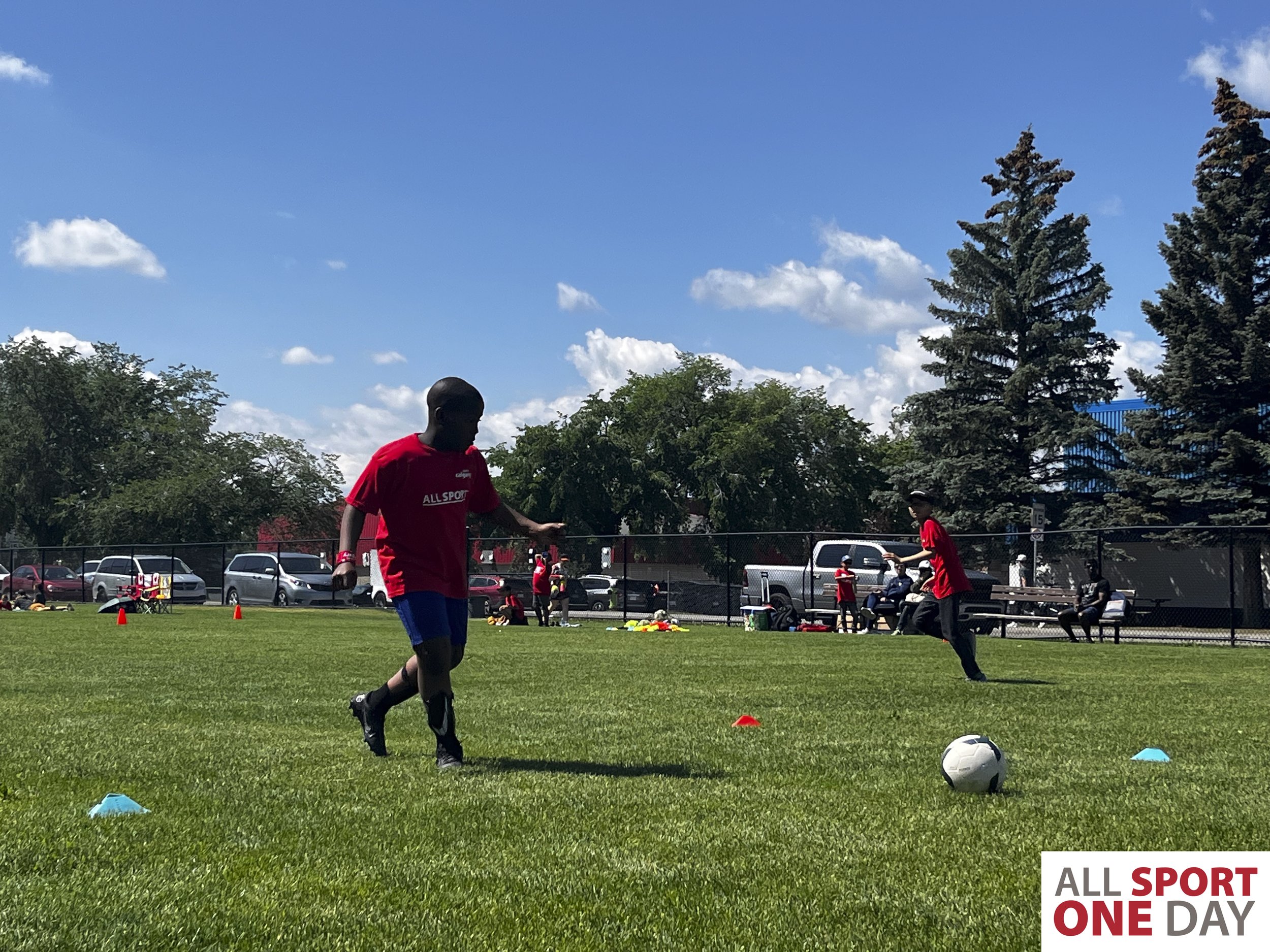
Soccer
Soccer is a popular team sport that is played on a large field between 2 teams of 11 players each. Players will kick and dribble the soccer ball with their feet down the field with the objective of moving the ball into the goal of the opposing team to score points. The team with the most points at the end of the game wins.
Soccer has a long history in several different ancient cultures around the world. The earliest known record originates from China during the Han Dynasty. Here in North America, the Algonquians played a game similar to soccer, which was played by upwards of 500 to 1000 participants.
No special skills are required to start playing soccer. You’ll be making use of your entire body as you run, sprint, kick and maybe even dive and jump for the soccer ball. You can play with a soccer club, or as a casual game with your friends and family.
Please contact the soccer provider of your choice to ask if they are able to provide any accommodations or information on programs for individuals with physical and/or cognitive disabilities.
-
Increased cardiovascular health.
Increased strength.
Improve teamwork skills.
-
There is no special equipment required for playing soccer. All you need is to wear comfortable clothing, a pair of running shoes, or cleats, a soccer ball and some friends. You can find soccer goalposts on several neighbourhood and/or school fields.
If you want to play with a club/league, you may be required to purchase a uniform and cleats.
-
Common soccer injuries include bruises, sprains, and strains. More serious injuries include fractures, dislocations and concussions. Ensure that you’ve warmed up and stretched thoroughly before playing. Be aware of your surroundings to avoid injuries to yourself and other players.

Softball
Similar to baseball, softball is played on a diamond with four bases and has one team fielding while the other team bats. In softball the pitches must be thrown underhand, and the teams can be mixed. In north America most softball is played recreationally, but professional leagues exist in Asia, South America and Europe.
Softball was spontaneously invented in 1887 in Chicago, where a crowd of fans eagerly awaited the results of a football game inside a local football club between Yale and Harvard, which Yale won. A happy Yale fan threw a boxing glove at a Harvard fan, who swung at the glove with a broomstick. In response, an innovative reporter tied the boxing gloves together to create a makeshift ball and used chalk to draw the bases, and softball was born!
Once learning how to throw and catch all ages can participate. The distance between bases can be increased or decreased based on age and ability.
Wheelchair softball does exist and other adaptations like using velcro mitts and balls or using a lighter and wider bat can be made so more players can get involved.
-
Improves self-esteem.
Teaches teamwork.
Builds leadership skills.
-
The equipment required depends on the level of competitiveness. Recreational softball only requires a bat, ball, glove and helmet. If you play more competitively one might need cleats, batting gloves and some protective equipment.
-
Most injuries occur due to contact with the ball. Pitchers are more susceptible to injury because of their placement on the field and the repeated body movements they perform.

Speed Skating
Speed skating is a competitive ice-skating sport where athletes race against each other, individually or in teams, for a certain distance around an ice track. Different types of speed skating races include short-track speed skating, long-track speed skating, team pursuit and marathon speed skating.
The very first speed skating competition happened in England in 1763, while the first speed skating competition for women occurred in the Netherlands in 1805. Eventually, speed skating entered the Olympic program in Chamonix in 1924.
To get started with speed skating, you must be comfortable in skates and on the ice. Being able to control your speed, start, stop, and handle curves/turns at high speeds are key. If you are looking to start skating, there are several clubs and programs that will start you off on the right skate!
Although a formal program for adaptive speed skating has yet to be created, there are adaptive speed skates in development for individuals with physical disabilities. Please contact your preferred speed skating club to ask about accommodations.
Similar Sports: Figure Skating, Synchronized Skating, In-line Skating
-
Improved cardiovascular fitness.
Increased muscle strength.
Improved coordination and balance.
-
When you’re starting out, you’ll need a pair of speed skates, which can be rented at some skating facilities, fitted athletic clothing, a helmet, skating gloves, shin, elbow, and knee pads. If you’d like to speed skate more competitively, you may be required to purchase a speed skating suit and speed skates.
-
The most common speed skating injuries include back pain, pulled muscles, cuts, and in some cases, dislocated shoulders. Ensure that you have stretched and warmed up thoroughly before hitting the ice. Follow all safety procedures to avoid getting yourself, or other skaters injured.
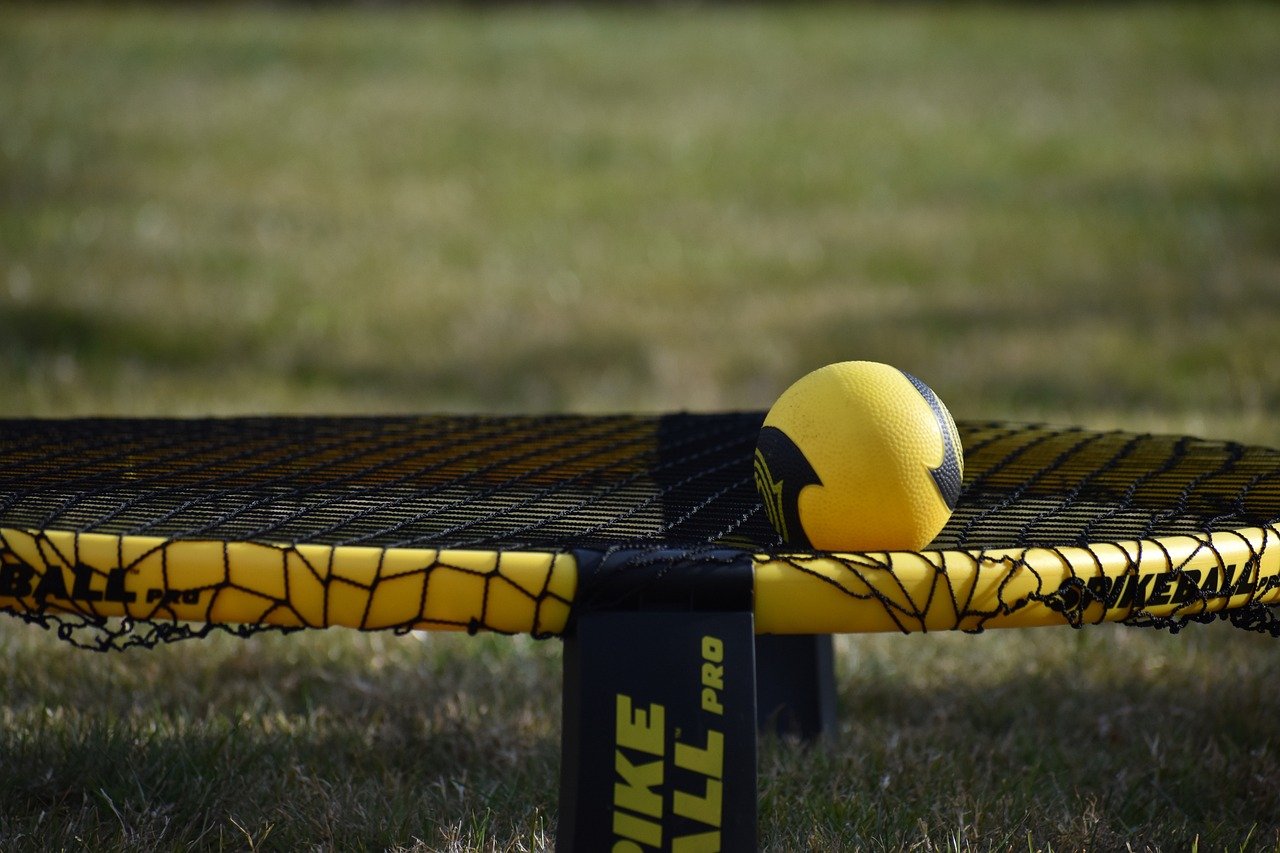
Spikeball
Spikeball (or roundnet), is a ball game played between 2 teams with 2 players each (or with 6 players split into teams of 3). Players start by surrounding a round net that’s low to the ground and serving the ball to the net, where the ball bounces off for the other team to return the ball back to the net.
The game was invented in the 1980s by a man named Jeff Knurek, inspired by the game of volleyball. It was popular for only a brief period before coming back into popularity in 2015.
No prior skills are needed to get started with spikeball. It requires being light on your feet, quick reflexes, and hand-eye coordination. The more you play, the more your skills will improve.
Although there is no official adaptable version of the game, you can modify the rules, and/or play on a different terrain to make it more accessible for all players.
-
Increased strength and endurance.
Improved hand-eye coordination.
Improve teamwork skills.
-
You'll need a spikeball net, and a spikeball. Wear comfortable clothes and shoes.
-
The most common spikeball injuries occur to the shoulders, knees, elbows and ankles due to overuse. Collisions with other players and falls are other risks that participants need to be aware. Don’t forget to stretch and warm up before playing to avoid any injuries!
Similar Sports: Volleyball

Spin Cycling
Spin cycling is a type of indoor cycling that is done on stationary bikes in classes typically led by an instructor. These spin cycling classes focus on improving endurance and strength, with curated routines and music.
Spin cycling began when people began to take cycling indoors during the late-19th century, however it wasn’t until 1987 when spin cycling was developed into a fitness program by a South African cyclist named Jonathan Goldberg.
No special skills are needed to begin spin cycling. You don’t even need to know how to ride a bike to start! You’ll be able to adjust bike settings to your level and gradually increase it as you build your strength and endurance. Keep in mind that you’ll need to have enough mobility in your legs to pedal for the duration of the class.
There are several emerging programs that aim to make spin cycling more adaptive for those with physical and/or cognitive disabilities using specialized equipment, such as hand bikes. Although these adaptive spin cycling programs have yet to be created in Calgary, please feel free to contact your spin cycling provider to ask if they are able to offer any accommodations.
-
Improved endurance.
Increased strength.
Improved cardiovascular health.
-
Come to spin cycling classes in comfortable clothing for exercise. Wear a pair of athletic shoes, bring water, and a towel for sweat. Stationary bikes will be provided for you at the spin cycling facility.
-
Soreness, muscle strains, back pain and joint stress are all risks that come with spin cycling. Much of this can be avoided by not overexerting yourself, stretching, and warming up thoroughly before you get on the bike. Ensure that your bike settings are set to your ability level; you can increase the difficulty as you gain more strength.
Similar Sports: Biking/Cycling, Track Cycling

Squash
Squash is a racket sport played by 2 to 4 players in a walled court where players take turns alternating hitting the small, hollow rubber ball against the walls. The goal of the game is to hit the ball against a wall in a way that the player on the opposing team is unable to return the ball.
An early version of squash first appeared and spread around schools in the mid-19th century in London, which soon gained popularity among other schools and clubs, leading to its spread to North America. The official rules for squash were set in 1912 in Queens, New York by the Tennis, Rackets & Fives Association.
You do not need to have prior knowledge or experience before getting started with squash. It is a fast-paced and physically demanding sport that requires quick maneuvering around the court and swinging a racquet to hit the ball.
Adaptive versions of squash are currently being developed and tested for players with physical and/or cognitive disabilities. Wheelchair squash is emerging as an accessible way to play the sport, with modifications made to the balls and racquets to make playing accessible.
Similar Sports: Badminton, Raquetball, Tennis
-
Improved agility and hand-eye coordination.
Improved cardiovascular health.
Increased flexibility and back strength.
-
You can rent or purchase a squash racquet and ball. Many sports facilities, and/or recreation centres have squash courts that you can reserve.
-
Squash is fast-paced and can be intense. Be aware that you will be at risk for muscle strains and sprains, falls and head and eye injuries. Remember to warm up and stretch thoroughly before playing. Be aware of your surroundings and of other players to avoid any injuries to yourself or someone else.

Swimming
Swimming is a water sport that is done recreationally, competitively, and can also be used for therapeutic purposes. You can swim in pools, lakes, and even in the ocean if you have the skills to do so.
The earliest record of swimming for recreation originates from 10,000-year-old wall paintings. The leisurely pastime didn’t become a competitive sport until the 1830’s in England, and the first swimming association was established in 1880.
No special skills are needed to start learning how to swim. You’ll begin by learning how to float to become comfortable in the water before moving on to basic swimming techniques.
Adaptive swimming adjusts techniques and use of floatation devices to make swimming accessible to those with physical and/or cognitive disabilities. Several facilities in Calgary offer adaptive programs for kids and adults with disabilities.
Similar Sports: Artistic Swimming, Water Polo, Underwater Hockey
-
Increases endurance
Improves cardiovascular health
Increases muscle strength
-
All you need to swim is swimwear! For competitive swimming, goggles and a swim cap are required, otherwise they are optional if you choose to swim recreationally. Don’t forget to bring a towel to dry yourself off afterwards.
-
The most common swimming injuries occur in the shoulders, neck, lower back, and knees. These injuries are usually the result of overuse, so ensure that you are warming up and stretching thoroughly before getting into the water. Before heading into the deeper end of the pool, make sure that you are comfortable and confident enough, and have the necessary skills to do so.

Synchronized Skating
Synchronized skating is an ice-skating sport where teams of between 8 to 20 skaters perform a high-speed and intricate routine with specific formations and elements from other disciplines of skating.
The first synchronized skating team was formed in 1956 in the United States, where it was originally called precision skating. The sport became popular in the 1970s with teams soon developing more complicated and intricate routines, with the first international competition occurring in 1976.
Before starting your synchronized skating journey, you must be comfortable with ice skating. Knowing how to stop and slow down when skating is essential for maneuvering around the rink and performing.
Skating from all disciplines, such as figure skating, have accommodations to make ice sports more accessible to participants with physical and/or cognitive disabilities. Please contact your synchronized skating provider and ask if they have specific accommodations for synchronized skating.
-
Improved balance and coordination.
Improved agility and flexibility.
-
You’ll need a pair of fitted figure skates and fitted athletic clothing. When competing/performing, you may need to order a custom costume.
-
Common injuries include bruises, cuts, scrapes, and sprains, especially in the knees, ankles, feet, hips, and lower back. Concussions can occur if skaters slip and fall onto the ice or collide with other teammates. Remember to stretch and warm up before hitting the ice. Be aware of your teammates and surroundings to avoid any serious injury.
Similar Sports: Figure Skating

Taekwondo
Taekwondo is a Korean martial art that is most notably characterized by high kicks, jumping and spinning kicks. It is a fast-paced sport that uses the entire body to kick, jump and strike opponents.
The sport of taekwondo is a relatively new martial art, with its rules and forms being standardized soon after World War II by practitioners with previous experience in Chinese and Japanese martial arts.
No special skills are required before starting taekwondo. You’ll learn all basic forms and techniques during your classes and advance in rank as you gain more experience.
Taekwondo can be adapted to fit the needs and abilities of participants of all ages and mobility. There are several adaptive taekwondo programs that are available in Calgary. Please contact the school of your choice to see if they can provide any accommodations for you.
-
Increased flexibility.
Boosts confidence.
Improves agility.
-
No special equipment is required for taekwondo. Depending on your school, you may be required to purchase a taekwondo uniform before attending your first class; otherwise, you may attend classes in a comfortable t-shirt and shorts or athletic pants.
-
Common injuries in taekwondo include bruises, strains and sprains with more serious injuries being fractures and concussions. It is always important to warm up and stretch thoroughly before practicing or competing. Follow all safety rules and be aware of your surroundings to avoid injury to yourself or other participants.

Tai Chi
Tai chi is a low-impact style of Chinese martial arts that involves a series of motions and forms that are performed slowly and meditatively. Unlike yoga, tai chi does not require you to hold any poses but will have you in constant movement without putting too much strain on your body.
Tai Chi originates from martial arts practices in Taoist and Buddhist monasteries in China. The sport was brought over to North America in the early 1930’s by immigrants from Hong Kong who taught tai chi in San Francisco’s Chinatown.
No prior skill is needed to start practicing tai chi. You don’t need to be very flexible to start. As you practice your forms during your classes, you’ll develop more strength and flexibility.
Tai chi is a very adaptable sport. Forms and movements can be adapted to fit the individual and their physical/cognitive needs. Contact your local tai chi/martial arts school to see if they offer any accommodations that will fit your needs.
-
Increased muscle strength and flexibility.
Improves balance.
Accessible and adaptable.
-
No special equipment is needed. Come to classes in comfortable clothes and shoes.
-
Although a relatively safe sport, improper practice can lead to joint injuries and strained muscles. Warming up and stretching before starting will decrease the risk of injury while practicing. Be aware of your surroundings and other participants to avoid injuring yourself or others.
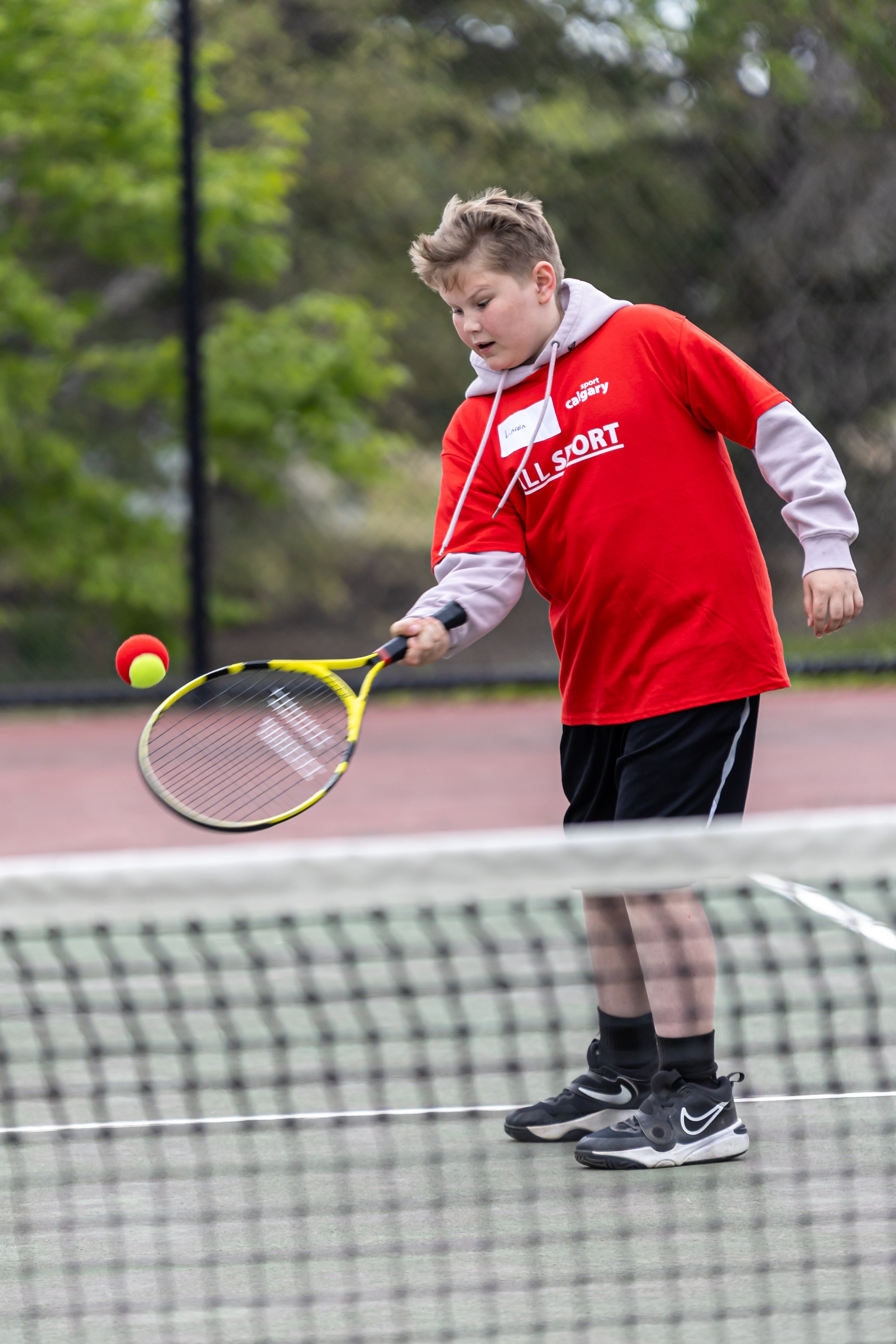
Tennis
Whether you are in it to win it or just to have some fun; tennis is a sport everyone can enjoy. Tennis is an Olympic sport that is played all around the world. It can be played as either singles or doubles. A match consists of an odd number of sets, usually three or five, with the winner being the first to majority.
Tennis originates from 12th or 13th century France, where bare hands were used instead of rackets. By the 16th century, the use of rackets became standard, and it had established rules. Soon, tennis became a popular game for aristocrats across Europe and was especially popular in Victorian England.
No matter your age tennis is a great sport to get into, as it requires no prior skills. Communities will usually have a set of public tennis courts available making it a low budget activity.
Tennis is accessible to anyone who can pick up a racket. Wheelchair tennis is quite a popular version of the sport and is played very similarly with just a few rule changes.
Similar Sports: Badminton, Padel, Pickleball, Squash
-
Improves bone health
Enhances coordination
Boosts brain power and mood
-
The most important equipment for playing tennis would be a ball, your racket and your shoes. Tennis involves a lot of quick movements so make sure you have good shoes to support you.
-
Generally, the risk for injury is low. Overuse injuries can occur such as tennis elbow. When playing out in the sun be sure to watch for signs of heat exhaustion.
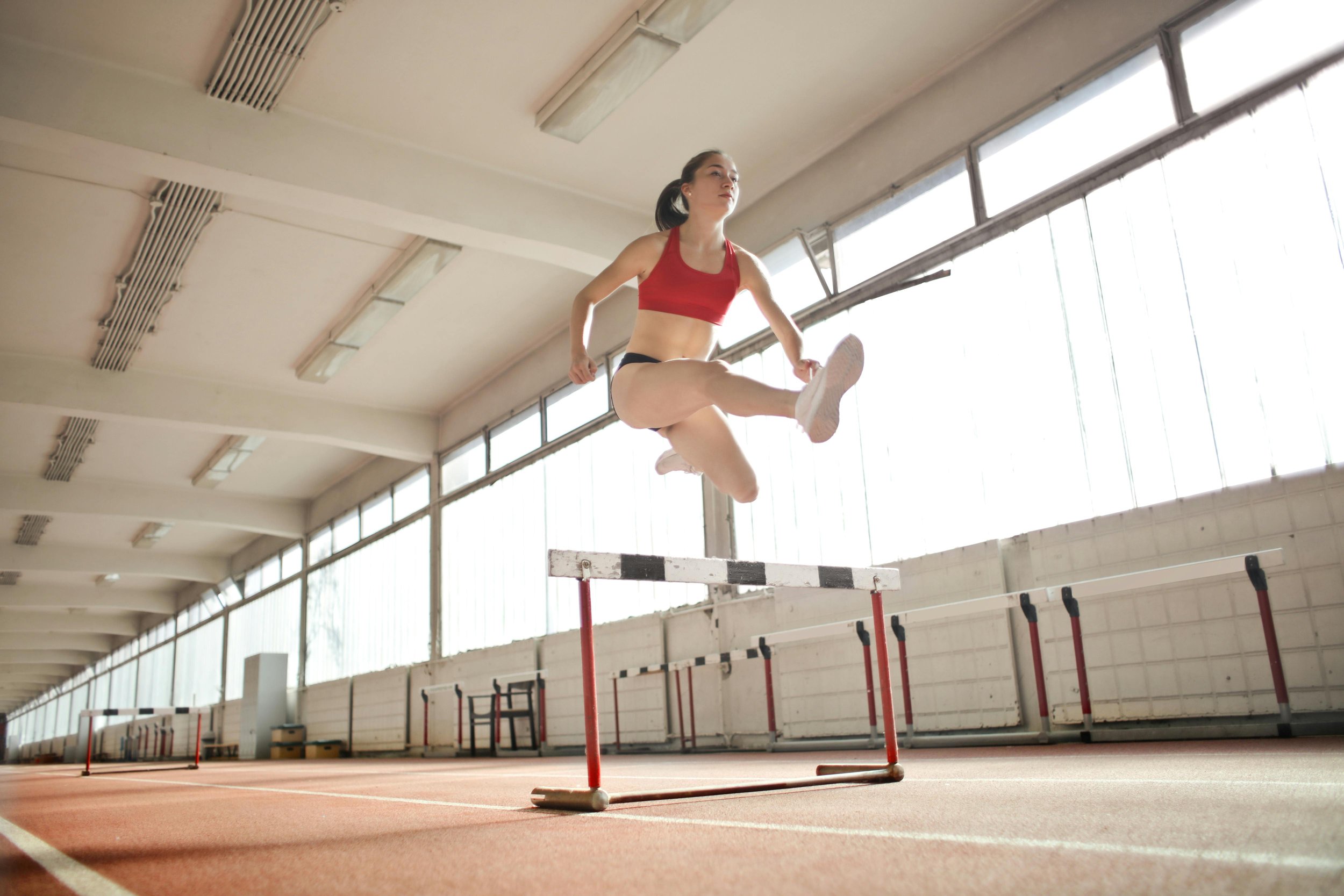
Track & Field
Track, or track and field, is a sport that involves various athletic competitions that involve running, jumping, and throwing events. These sports are played in a stadium, or arena with both a running track and a field for athletes to compete in. Common track sports include relay racing, shot put, and long jump.
The first recorded track competitions have its roots in Ancient Greece and is one of the world’s oldest sporting competitions.
No prior special skills are needed before starting track. Track is a series of sports that utilizes the entire body and takes lots of practice to master. You’ll learn the rules and basic skills of the sport of your choice during your lessons and practice.
Track has been made accessible for participants with physical and/or cognitive disabilities. Adjustments and modifications to facilities, rules and equipment are made to make participation accessible to all.
Similar Sports: Gymnastics, Speed Skating, Track Cycling
-
Increased cardiovascular health and endurance.
Increased flexibility and balance.
Builds teamwork skills.
-
Certain sports will require certain kinds of equipment such as javelins, hurdles, or poles, which can be provided at track facilities. Wear comfortable athletic clothing. Depending on the sport, you may want to wear fitted clothing to avoid getting equipment caught in clothes.
-
The most common injuries for track and field athletes are strains and overuse injuries to various parts of the body. Athletes must make sure that they warm up and stretch properly, while also ensuring that they do not overexert their bodies while training.
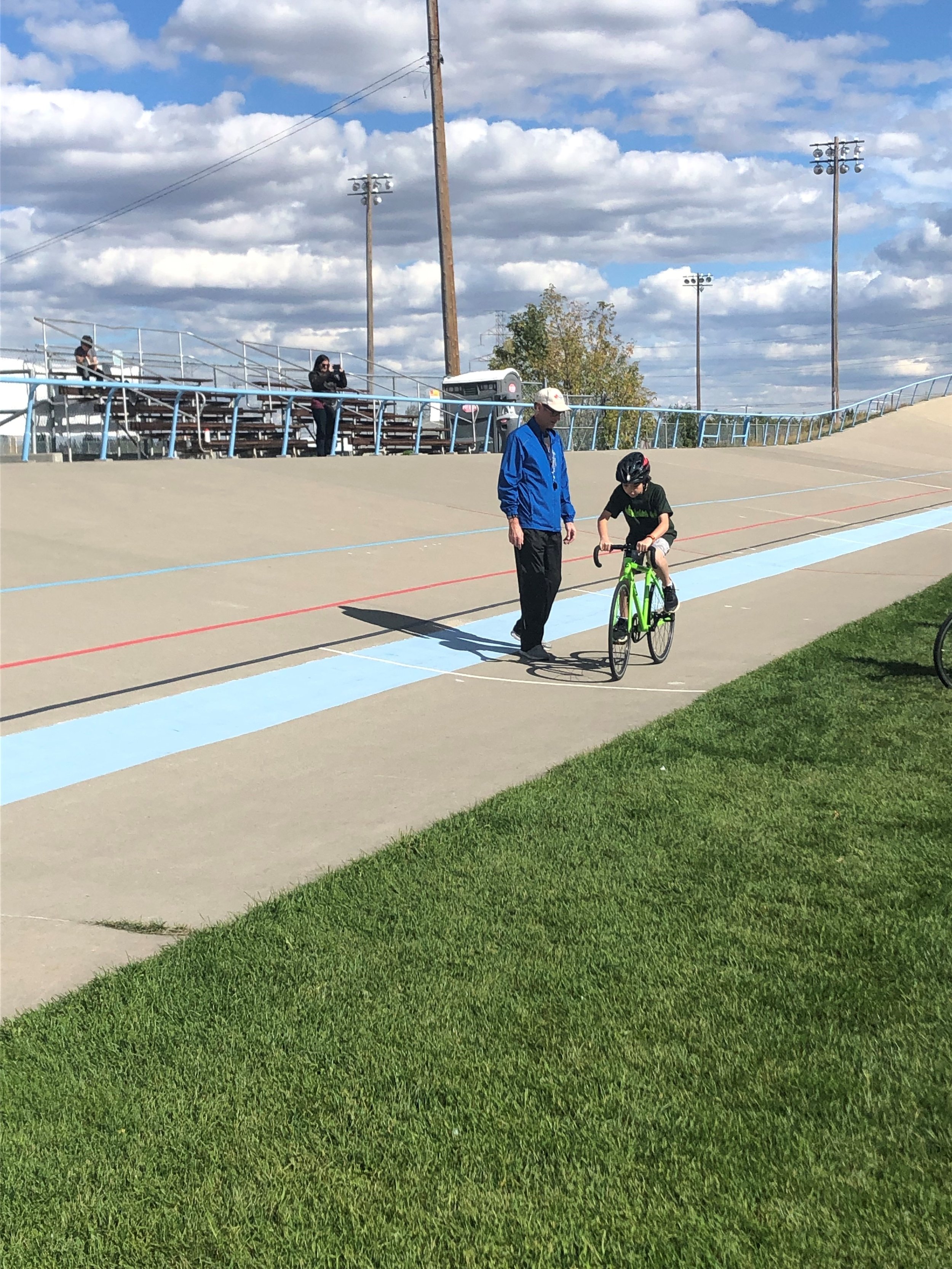
Track Cycling
Track cycling is a bike racing sport where cyclists compete against each other on a specialized oval-shaped sloped track in a venue called a velodrome. Cyclists will ride single gear track bicycles, which differ from road bikes in that it does not have a freewheel or brakes, and will usually compete individually or in team races.
The sport has existed since the late-19th century, with several British cities, such as London and Liverpool, being the centre of the track cycling world. Men’s track cycling became an Olympic sport in 1896, while women’s track cycling was inducted into the Olympics in 1984.
Before getting started with track cycling, you’ll need to be comfortable riding a bike. If you can ride a bike, then you can do track cycling! You’ll get some time to practice riding track bicycles before getting onto the track, and then it won’t be long before you’re coasting around the track!
Adaptive cycling allows individuals with physical disabilities the opportunity to bike and get on the track at the velodrome. At the Olympics, para cyclists with a visual disability will ride and compete with a guide called a “pilot.” Adjustments and specialized bikes such as the hand cycle, allow those with physical disabilities to be able to compete in events such as road races. Please check with your preferred track cycling club/league to see if they can provide any accommodation for you.
Similar Sports: Biking/Cycling, BMX, Mountain Biking
-
Increases core muscle strength.
Improves cardiovascular fitness.
Improves balance and hand-eye coordination.
-
You’ll need a helmet, cycling gloves and comfortable clothes and athletic shoes to ride in. Track cycling leagues, such as the Calgary Bicycle Track League, have track bicycles available to borrow if you’re new to track cycling.
-
The most common track cycling injuries involve bruises, scrapes, and sprains, lower back and shoulder pain. Ensure that you stretch and warm up thoroughly before getting on the track. Follow all the safety rules of the velodrome and be aware of other cyclists to avoid injury to yourself and to other cyclists.

Trampoline
Trampoline is a sport that involves participants bouncing on a trampoline 10 x 17 ft in size up to 8 metres into the air while performing highly acrobatic routines.
The trampoline used for the modern sport was developed in the early 1930s by an American gymnast after observing acrobats perform tricks while bouncing off safety nets.
You do not need any prior skills to start trampolining. It is a highly technical sport that utilizes the strength of the entire body and requires lots of time and practice before you can master it. You’ll learn the basics and develop these skills in your lessons.
Although there has yet to be an adapted version of trampoline, you may contact your trampoline provider and ask if they offer any accommodation for participants with a physical and/or cognitive disability.
-
Increase in flexibility and cardio strength.
Improves balance and coordination.
-
Come to classes in fitted and comfortable athletic clothing to avoid anything getting caught in equipment.
-
Common injuries from doing trampoline include sprained ankles and knees, back pain, and muscle strain to various parts of the body. Remember to stretch and warm up thoroughly before getting on the trampoline. Be aware of your surroundings to avoid injury to yourself and others.
Similar Sports: Gymnastics, Parkour

Triathalon
Triathlon is an endurance-based competition where competitors swim, cycle and run various distances, aiming to complete the race in the fastest time possible. Competing in a triathlon requires months of preparation and training to build up the necessary endurance and strength.
Early variations of the triathlon are believed to have origins in France starting in the early-twentieth century. The modern-day version originated in Southern California where sports clubs developed the rules of the competition.
Training for a triathlon requires discipline and adherence to a consistent training schedule in all three sports. You must be comfortable with riding a bike, running for long distances, and being in the water. Be prepared to start training months in advance to be able to compete in a triathlon.
Making triathlons more accessible to all participants regardless of physical and/or cognitive disability involves making modifications to equipment, the course, and the rules. Check to see if the triathlon you’re interested in competing in has any accommodations that will fit your needs.
Similar Sports: Biathlon, Running, Track & Field
-
Increases endurance and stamina.
Full body workout.
Increase in energy.
-
You’ll need proper running shoes, running shirt/tank top and shorts or trisuit, water bottle(s), a road bike, helmet, and/or cycling shoes, a wet suit or swimsuit, swim cap and goggles.
-
Common injuries for triathletes occur mostly from overuse in the arms and legs, as well as tension and soreness in the neck and back. Stretch and warm up thoroughly and to remember to not overexert yourself while training and get adequate rest when needed.

Ultimate
Ultimate, or ultimate frisbee, is a team sport that uses a flying disc (frisbee). Each team has 7 players, and the goal of the sport is to score points against the opposing team by catching the frisbee in their end zone. This sport is no-contact, meaning that physical contact, such as tackling other players to the ground, is not allowed.
The sport originated at a New Jersey high school in 1968. It was designed to combine elements from various sports such as American football, basketball and soccer. The students who developed the rules soon took the game to college campuses and eventually became a popular sport across North America.
No special skills are required to learn how to play ultimate. It is a sport that uses the entire body, as you will be running, jumping and even diving for the frisbee on the playing field.
Wheelchair ultimate is a variation of the game that allows participants with physical disabilities to participate in the sport. The University of Calgary offers ultimate as a part of their “Adaptive Physical Activity for Kids” program. Please contact them, or an ultimate frisbee league of your choice for more information.
Similar Sports: American Football, Soccer, Frisbee, Disc Golf
-
Improved motor skills.
Increased endurance.
Improved teamwork skills.
-
No specialized equipment is required. All you need is a frisbee, which may be provided by your club or league. You’ll need to wear comfortable clothing and athletic shoes for running. You can wear cleats if you’d like but ensure that they’re not metal to avoid injuring yourself and other players.
-
Sprains, strains and bruises are all common injuries that occur while playing ultimate. Dislocations and concussions are also more serious risks that can occur. As with any sport, remember to warm up and stretch thoroughly before playing. Be aware of your surroundings and of other players as you play to avoid any serious injuries.
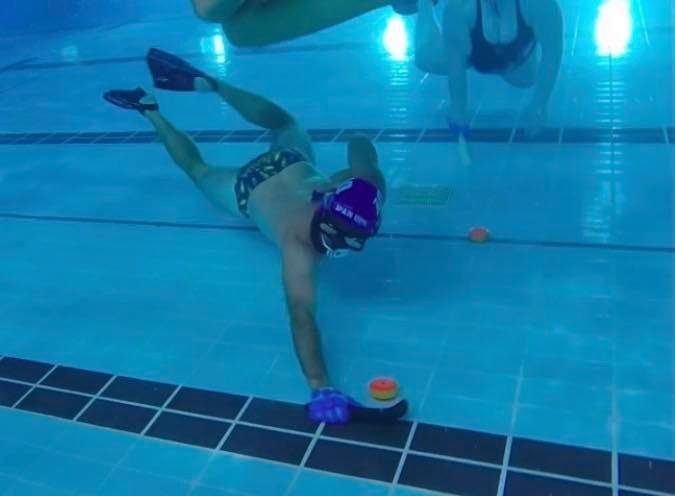
Underwater Hockey
Underwater Hockey is exactly what it sounds like! It’s a limited-contact sport that is played on the floor of a swimming pool between two teams of 6 that compete to maneuver the puck into the goal of the opposing team to score points.
The sport was started in the United Kingdom in 1954, meant to keep members of the Southsea Sub-Aqua Club active during the cold winter months. The sport was introduced to Canada in the 1960s, where an Australian dive shop owner introduced it to a Vancouver dive club.
Make sure that you are comfortable in a pool wearing a diving mask and snorkel and have the capacity to hold your breath while playing. This is a sport that requires players to be strong swimmers, but don’t let it stop you from training and honing your skills!
There has yet to be an official iteration of an adaptable version of underwater hockey, however, please ask your local underwater hockey club to see if they are able to make accommodations for players with physical and/or cognitive disabilities.
Similar Sports: Floorball, Ice Hockey, Lacrosse
-
Increased stamina/strength
Increased flexibility
Improved cardiovascular health.
Build teamwork skills.
-
To play, you’ll need proper swimwear (nothing baggy, as they can reduce speed when playing), a diving mask and snorkel, fins, stick/pusher, a puck (made of lead, or lead-based material), a cap and gloves for protection.
-
Although it is a limited-contact sport, participants can still sustain injuries such as sprains, torn muscles, and scratches. More serious injuries, such as concussions are possible, but the safety of players is carefully monitored by referees during the game.
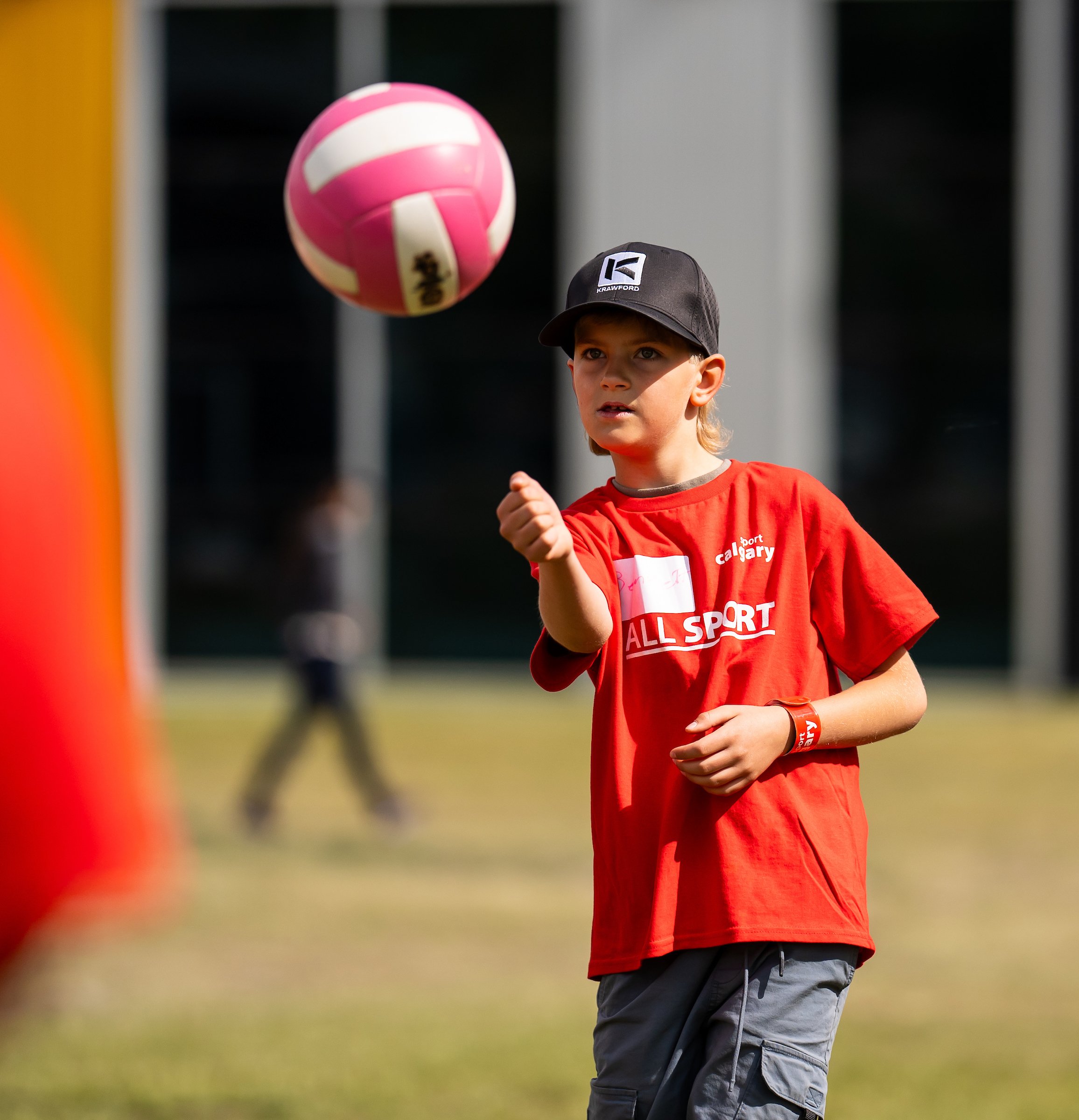
Volleyball
Volleyball is a team sport in which 2 teams of 6 players rally a volleyball back and forth over a net on a court 60 x 30 ft wide to score points against the opposing team by grounding the ball on their side of the divided court.
The sport was developed in the United States in the late-1800’s and quickly became popular worldwide in the 1900’s. Volleyball became a part of the Summer Olympics in 1964.
No special skill is needed to play volleyball. It’s a sport that requires lots of running, jumping and even diving on the court, so be sure to warm up and stretch well before playing.
There are several versions of volleyball that have been adapted to meet the needs of players with physical disabilities. One such version is called sitting volleyball, where players remain seated for the duration of the game and play on a smaller court with a lowered net.
-
Increase muscle strength.
Improved hand-eye coordination skills.
Builds teamwork.
-
No special equipment is needed to play. You'll need a volleyball and comfortable clothing and athletic shoes. There are several facilities where you can rent volleyball courts to play on.
-
Volleyball injuries often occur in the arms and legs. Wrist and knee pain, sore forearms, and sprained ankles are common. Remember to stretch and warm up thoroughly before you begin playing.
Similar Sports: Beach Volleyball, Wallyball, Spikeball

Wakeboarding
Wakeboarding is a water sport where a rider is strapped by the feet to a wakeboard, then towed behind a motorboat, using the waves created by the boat to perform acrobatic maneuvers in midair.
The first iteration of wakeboarding, which began in the United States in the 1950s, involved using a single ski to glide across the water. In the following decade, a surfboard replaced the ski before boards with straps, the wakeboard, began to be sold in Australia.
No special skills are required before starting to learn how to wakeboard. A good sense of balance is essential, but you’ll be able to practice and work on it as you learn how to wakeboard. Don’t get discouraged if you can’t get the hang of it on your first try! It’s a sport that requires lots of practice.
Water Ski & Wakeboard Alberta offers a special adaptive program called the “Splash Adaptive Program” for individuals with physical and/or cognitive disabilities to try wakeboarding and other water sports in a safe and comfortable environment. Contact them to see how you can join the program.
Similar Sports: Waterskiing, Sailing, Rowing
-
Improved balance.
Increased muscle strength.
Increased flexibility.
-
Wakeboards come in different styles such as the continuous rocker, the 3-stage rocker, and the hybrid rocker. Ensure that the wakeboard matches your height and skill level. As a beginner, you may want a wider board for greater stability.
A rope is needed to attach to the boat and for the rider to hold onto while the boat is moving. The rope can vary in length and material, and all depends on the preferences of the rider.
Most importantly, safety equipment such as life jackets, special water-resistant helmets and other buoyancy devices help lower the risk of serious injury.
-
Strains, sprains, scrapes and bruises are common wakeboarding injuries. More serious injuries include muscle tears, dislocations and fractures, most commonly to the legs. Remember to stretch and warm up thoroughly before hitting the water.
Be sure that your safety equipment, such as your life jacket and helmet, is on properly before wakeboarding. Remember that your safety is of utmost importance when you’re out on the water.

Wallball
Wallball, a popular schoolyard game, is a game where players hit a small ball against a wall using their hands, letting it bounce once on the ground, before the opposing player must hit it again to return it to the wall. Players win points if opposing players fail to return the ball to the wall. The player with the most points at the end of the game wins.
Wallball is one of the oldest ball games in the world, with origins tracing back to Rome, Spain, France and the British Isles. The game arrived in North America from Irish immigrants in the 1880s, with the first court being built in New York in 1886.
No special skills are required to play wallball. The rules are simple enough that you’ll be able to learn as you play. It is a highly physical sport, and will get your heart pumping and test your hand-eye coordination skills as you play.
Although there has yet to be any formal programs that offer an adaptive version of wallball, you are free to modify the rules to fit the needs for anyone with a physical and/or cognitive disability.
Similar Sports: Handball, Racquetball, Squash
-
Improves cardiovascular fitness.
Increase stamina.
Improve hand-eye coordination.
-
No special equipment is required. All you need is a sturdy wall and a small rubber ball, or tennis ball.
-
Common wallball injuries can include bruises and scrapes. More serious injuries may even include concussions. Remember to warm up thoroughly before playing and be aware of your surroundings and other players to avoid injuries to yourself and other players.
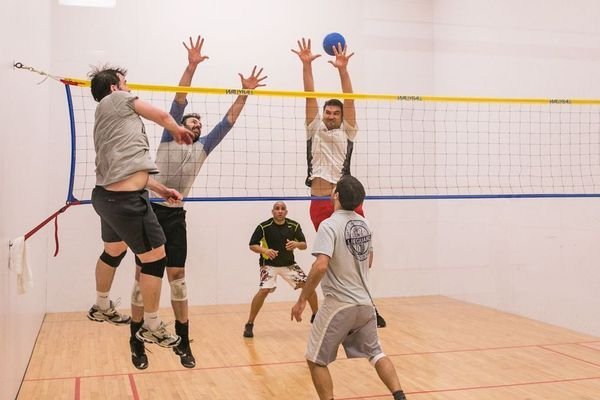
Wallyball
Wallyball is a sport like volleyball but is played on a racquetball court, where the walls are a part of the play. A net divides the court in half, with two teams each having 2 to 6 players each. The rules are similar to volleyball, but with a few exceptions.
The sport was invented in California in 1979 for the purpose of making use of empty racquetball courts, and to keep active during the winter months.
No special skills are needed to play wallyball. Like volleyball, it requires lots of running, jumping and even diving on the court. With the inclusion of walls being a part of play, the game becomes much more fast paced and exciting.
Although there is yet to be an adaptable version of wallyball, you can ask your wallyball provider to see if they are able to provide any accommodation for you.
Similar Sports: Volleyball, Racquetball
-
Increase muscle strength.
Improve hand-eye coordination
Builds teamwork skills.
-
You’ll need a volleyball, and a net. You can play in comfortable athletic clothes and non-marking shoes. Before you rent out a racquetball court, ensure that the facility allows for wallyball play.
-
Wallyball injuries often occur in the arms and legs. Wrist and knee pain, sore forearms, and sprained ankles are common. More serious injuries, such as concussions, may occur as well. Please remember to stretch and warm up thoroughly before playing. Be aware of your surroundings and of other players to avoid serious injury to yourself and others.
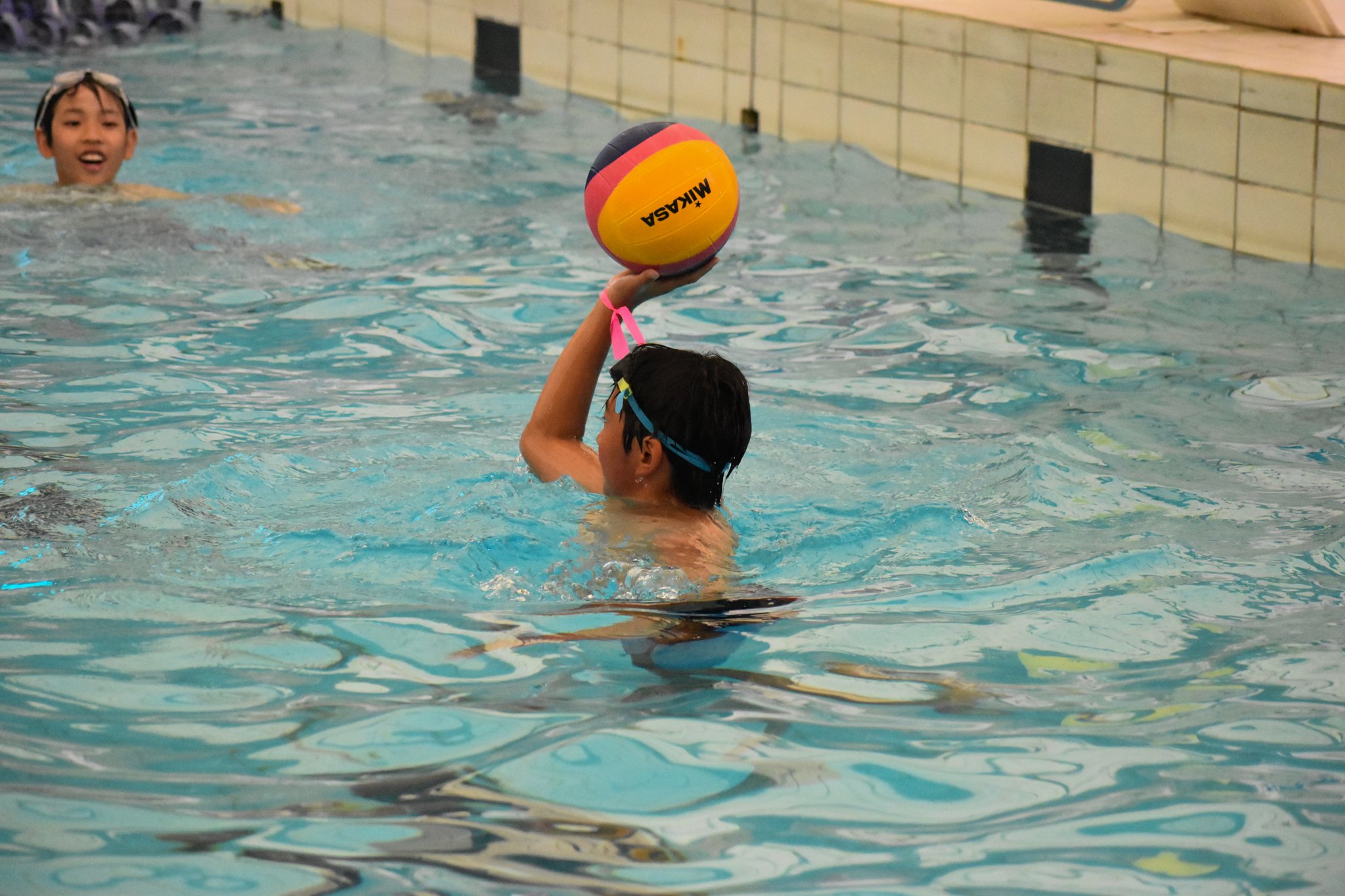
Water Polo
In earlier days, water polo was known as water rugby. It is a game of endurance and teamwork. The sport is played between two teams and each game is divided into four periods in which the two teams attempt to score goals by throwing the ball into the opposing team's goal. It is a popular sport in high schools, colleges, and even in the Olympic Games. It is vigorous, entertaining, and extremely fun to participate in.
While the origins of water polo are not clear, it is believed to have been invented in Great Britain during the 19th century, with its first iterations being similar to rugby. Water polo eventually became an Olympic sport in 1900.
The sport is played in the water - Expert swimming is not required, but participants should feel comfortable in the water! Floatation devices may be used, and every level of swimmer can participate and contribute!
Please feel free to contact your local water polo club to ask if they have any accommodations for you!
Similar Sports: Canoe/Kayak Polo, Water Basketball, Water Volleyball, Underwater Hockey
-
Cardio & full body workout
Builds endurance
Teaches strategy
Stress relief
-
Not much equipment is needed to play Water Polo. A net and a ball are required, and players wear simple swimsuits or trunks as well as swimming caps and goggles if required.
-
Water polo can be rough and much of the “contact” takes place underwater.
Proper warm-up and cool-down are important.
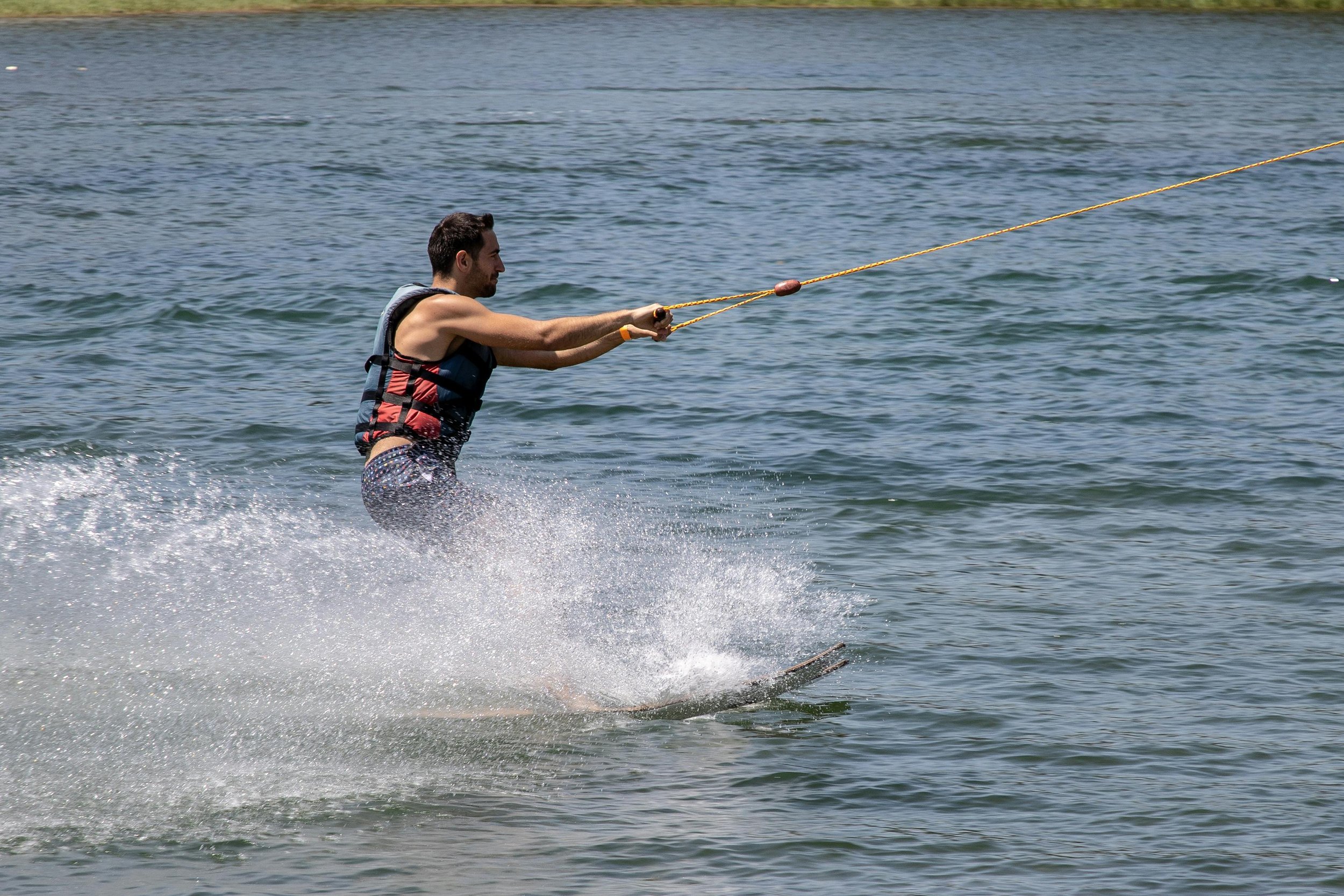
Waterskiing
Water skiing is a water sport where a rider glides across the surface of a body of water on a pair of skis while holding onto a rope that is attached to a moving boat. There are multiple different classifications of water skiing such as slalom style, ski jumping, show skiing and ski racing.
Water skiing first started in the 1920s in Minnesota, with the very first water skis made of lumber and leather strips. The sport didn’t start gaining popularity until the 1940s and 1950s when photographs of the Cyprus Gardens theme park, where water skiing was heavily promoted, began circulating internationally.
No special skills are needed to start water skiing. It does require a good sense of balance, core and arm strength, but you’ll be able to put in the practice as you learn how to water ski. Don’t get discouraged if you can’t get the hang of it on the first try! This is a sport that requires lots of practice.
Water Ski & Wakeboard Alberta offers a special adaptive program called the “Splash Adaptive Program” for individuals with physical and/or cognitive disabilities the opportunity to try water skiing.
Similar Sports: Wakeboarding, Sailing, Rowing
-
Improved balance.
Increased muscle strength.
Increased flexibility.
-
Just like snow skis, the perfect pair of water skis will depend on your height. The rope that will attach you to the boat will also depend on your preferences in length and material.
Most importantly, life jackets, special water-resistant helmets and other buoyancy devices help lower the risk of serious injury.
-
Strains, sprains, bruises and cuts to the shoulders, back and ankles are all common waterskiing injuries. More serious injuries include concussions or fractures and dislocations. Remember to stretch and warm up thoroughly before hitting the water to avoid any serious injury.
Be sure that your safety equipment, such as your life jacket and helmet, is on properly before waterskiing. Remember that your safety is of utmost importance when you’re out on the water.

Wheelchair Basketball
Wheelchair basketball is a variation of basketball where players use specialized wheelchairs to play on a standard sized basketball court and with a standard sized hoop. The sport utilizes most of the same rules for basketball, with modification to certain rules to adjust for wheelchair use.
The origins of wheelchair basketball go back to 1944, where an adaptive version of netball, along with other sports were played. In 1946, wheelchair basketball was played as a form of rehabilitation and socialization between American World War II veterans.
No specialized skills are required to start playing wheelchair basketball. Players will need to remain seated in the wheelchair throughout the duration of the game, as well as be prepared to make use of their arms to maneuver themselves around the court. Players do not need to have a physical disability to play.
Wheelchair basketball is already an adaptive version of standard/stand up basketball for individuals with physical disabilities however, everyone regardless of cognitive ability and mobility are welcome to play!
Similar Sports: Wheelchair Racing, Paracycling, Basketball
-
Increased strength.
Improved cardiovascular fitness.
Increased self-confidence.
-
Dress in comfortable athletic clothes and wear a comfortable pair of athletic shoes. Wheelchairs will be provided for you at the wheelchair basketball facility. If you have your own wheelchair, confirm with the facility to see if you can bring it in to play.
-
The most common wheelchair basketball injuries include shoulder, spine, neck and hand injuries, with many of these injuries caused by overuse. Ensure that you stretch and warm up thoroughly before playing, and that you know when to stop and rest.

Wheelchair Racing
Wheelchair racing is a sport of racing in wheelchairs around a track or in road races. Anyone with a qualifying physical disability (amputee, spinal cord injury, cerebral palsy) can participate. Athletes race in specialized wheelchairs that allow them to reach speeds of up to 30 km/h or more.
In 1960, the International Stoke Mandeville Wheelchair Sports Federation was formed to allow international competition for individuals with spinal cord injuries. This was expanded in 1976 to include competition for anyone with other physical and visual impairments and would eventually evolve to become known as the Paralympics.
Races take place on a track that include race distances that range from 100 to 10, 000 metres. Wheelchair racing utilizes arm and core muscles the most, which will help you build stamina and endurance.
You will need specialized wheelchairs for racing along with protective gear to participate.
Similar Sports: Paracycling, Wheelchair Basketball
-
Increased muscle strength in the arms, chest, and shoulders.
Increased flexibility and mobility in the shoulders.
-
A good wheelchair that fits you well is important. You’ll also need a helmet, gloves and spare racing and training wheels.
-
Shoulder, wrist, and elbow injuries are the most common. You may develop blisters and abrasions on your hands and arms, as well as weakness or numbness in the hands. Make sure to stretch and warm up thoroughly.

Winter Guard
Winter guard is a competitive performance art and sport which includes choreographed staging, dance, and use of equipment such as flags and prop rifles. Unlike colour guards, winter guard performances are held in indoor venues and to recorded music.
The sport developed from the colour guards/flag corps, which were originally performed in military ceremonies alongside a marching band during peacetimes.
You do not need to know any special skills before starting the sport. You’ll be able to learn all the necessary skills during lessons.
Winter guard can be adapted to make it more accessible for participants with physical and/or cognitive disabilities. Indoor venues make it easier to maneuver around the competition space. Contact your local winter guard troupe to see if they can make accommodations for you.
Similar Sports: Baton Twirling, Rhythmic Gymnastics, Dance
-
Increased cardiovascular fitness.
Increased strength and flexibility.
Learn teamwork and leadership skills.
-
Winter guard involves the use of different props and equipment, such as prop rifles, flags, and sabers, that will be provided to you in class. Make sure to come to your classes in comfortable, fitted clothes that you’ll be able to move around comfortably in.
-
Winter guard involves dancing and being able to spin, toss, and catch objects into the air, so concussions are possible if routines are not executed properly. Sprains, strains, bruises, fractures, and dislocations are all possible injuries. Remember to stretch and warm up properly before carrying out routines.

Wrestling
Wrestling is a contact sport that involves grappling, throwing, holds, and pins to score points against an opponent. Different wrestling disciplines include freestyle, Greco-Roman, and collegiate wrestling, that each have a different style and set of rules.
15,000-year-old wall paintings from France are the earliest records of wrestling, however it played a very prominent role in Ancient Greek culture. Wrestling became a part of the Olympic Games in 1904 in St. Louis.
No special skills are needed to start wrestling. Wrestling clubs will provide you with a safe environment to learn basic techniques and skills. You will be making use of your entire body, so ensure that you have good mobility before participating.
Seated wrestling is a variation of wrestling that adjusts techniques and exercises specific skills to make the sport accessible for those with a physical disability. Please contact your preferred wrestling provider to see if they can provide any accommodation.
Similar Sports: Aikido, Brazilian Jiu-Jitsu, Jiu-Jitsu
-
Increased strength
Increased endurance
Improved focus
-
For beginners, you will need to wear comfortable and fitting clothes. Ensure that you aren’t wearing any loose and/or dangling accessories and/or jewelry. Remember to bring a water bottle and towel. For those who wish to compete in competitive wrestling, you may need to purchase protective equipment, such as a mouth guard and knee pads, and a wrestling singlet.
-
The most common wrestling injuries are bruises, sprains, and strains to the wrist, elbows, knees and ankles. More serious injuries include fractures and concussions. Ensure that you are stretching and warming up thoroughly before you practice and/or compete. Follow all safety precautions and be aware of your surroundings to avoid any serious injury to yourself and your opponent.

Yoga
Yoga is a series of physical, spiritual, and mental wellness techniques with the aim of physical and mental wellbeing. Although there are several different kinds of yoga, the most popular and well-known type, called Hatha yoga, involves posture-based techniques and forms.
Yoga is thought to have originated in ancient India during the first millennium BCE becoming so widespread that it influenced Buddhist practices as the religion was being developed.
No prior skills are needed for yoga. It’s a low-impact sport that is slow paced and relaxing, however keep in mind that it may require you to balance, and hold poses for a short amount of time.
Yoga is an excellent sport that can easily be made adaptive for people with physical and/or cognitive disabilities. Techniques and stretches can be easily modified to fit the needs of the individual, and changes to the yoga space can accommodate for a more quiet and calming experience.
Similar Sports: Gymnastics, Pilates, Tai Chi
-
Improved physical and mental well-being.
Increased muscle strength, balance, and flexibility.
Boost in energy.
-
Comfortable clothes and a yoga mat.
-
Although relatively low impact, it’s important to know your limits and to not push yourself to do any techniques or poses that you are unable to hold. Gradually working your way to higher levels of complexity will benefit you more in the long run.
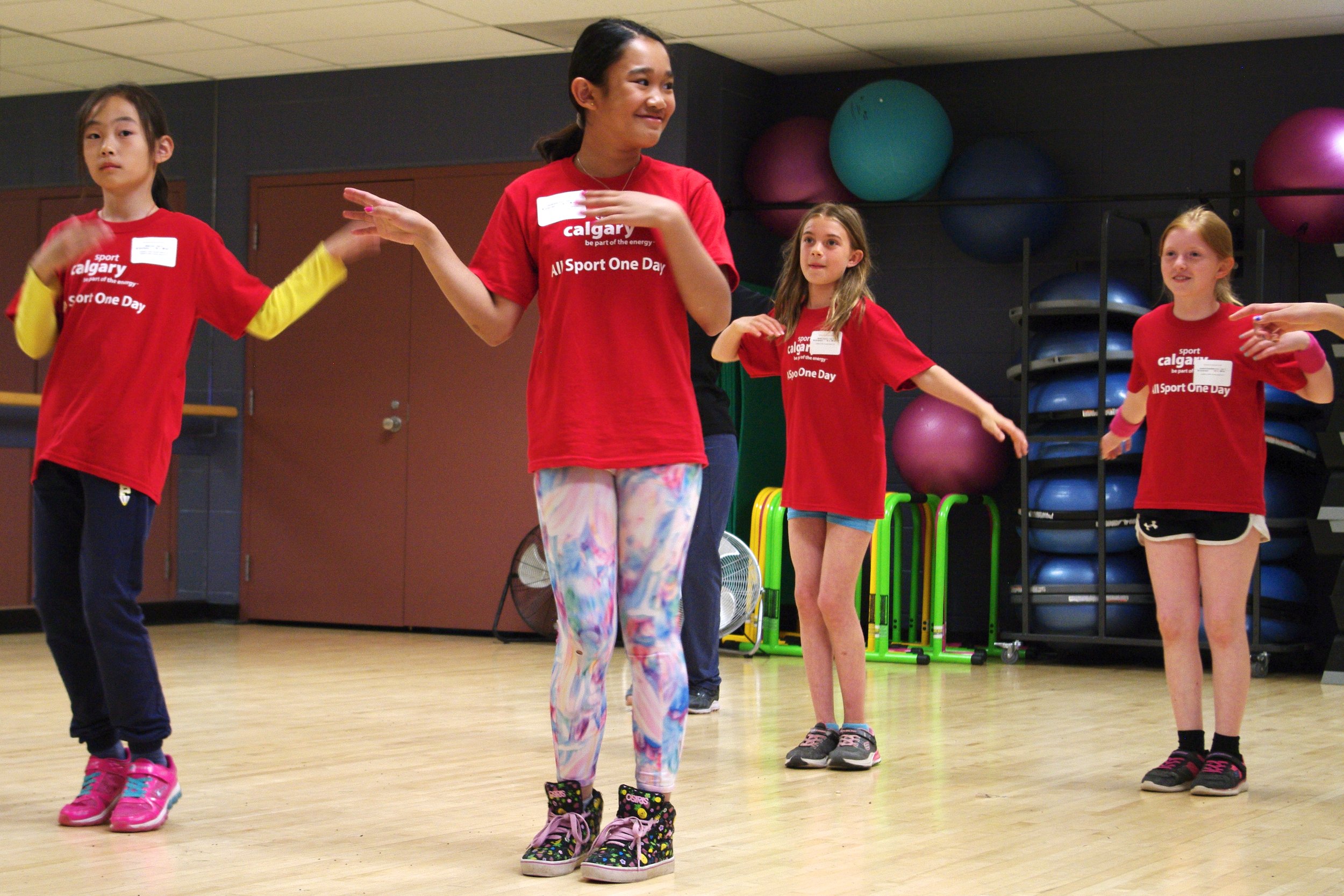
Zumba
Zumba is a fun and exciting cardio group exercise inspired by various Latin dances such as salsa, flamenco, and merengue. It is both a low and high-intensity workout with various dance moves that are designed to improve your endurance levels.
Zumba was created by a Colombian aerobics instructor in the 1990s, first calling it “Rumbacize”. Since then, Zumba has exploded in popularity worldwide and is practiced in recreation centres and homes worldwide.
No special skills are needed to start doing Zumba. It’s a full body workout that involves both high and low intensity sections to get your body moving. It’s a fun way to get your exercise in and feels more like a party than a fitness class!
Zumba can be adapted to fit all fitness and mobility levels. Wheelchair Zumba uses more arm movements and utilizes the rolling of the wheelchair as steps. Zumba studios can also be made more accessible by making changes to lighting, music, and number of class participants to make it a less intimidating and comfortable space.
-
A fun way to get exercise!
Increases endurance.
Improves hand-eye coordination.
-
No equipment is needed for Zumba. Come to class in comfortable clothing and a pair of athletic shoes.
-
The most common injuries for Zumba participants are knee, hip and ankle injuries. Remember to stretch and warm up thoroughly before class. Be aware of your surroundings and of other participants as you dance.
